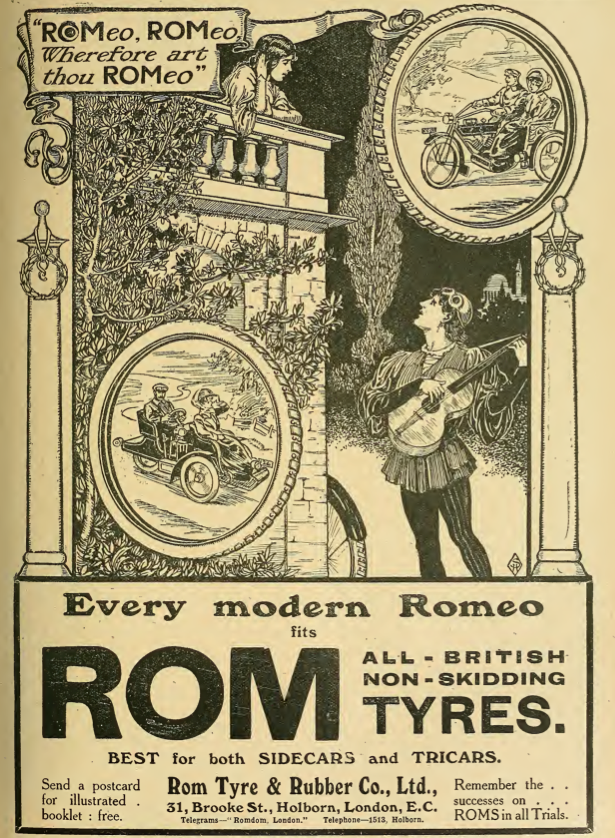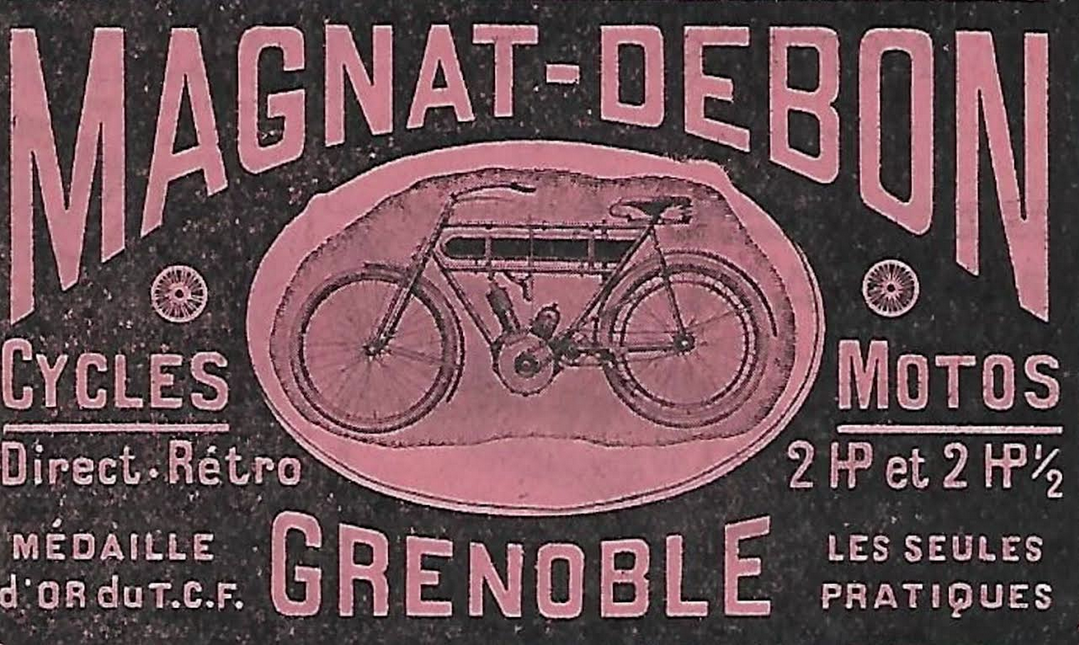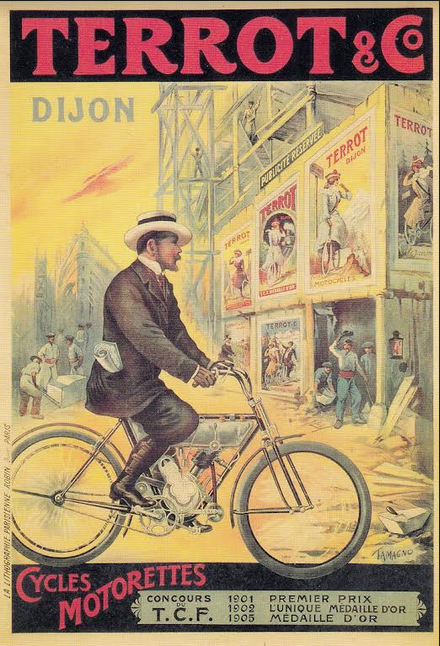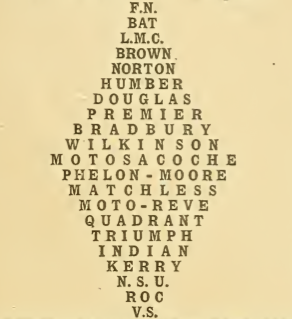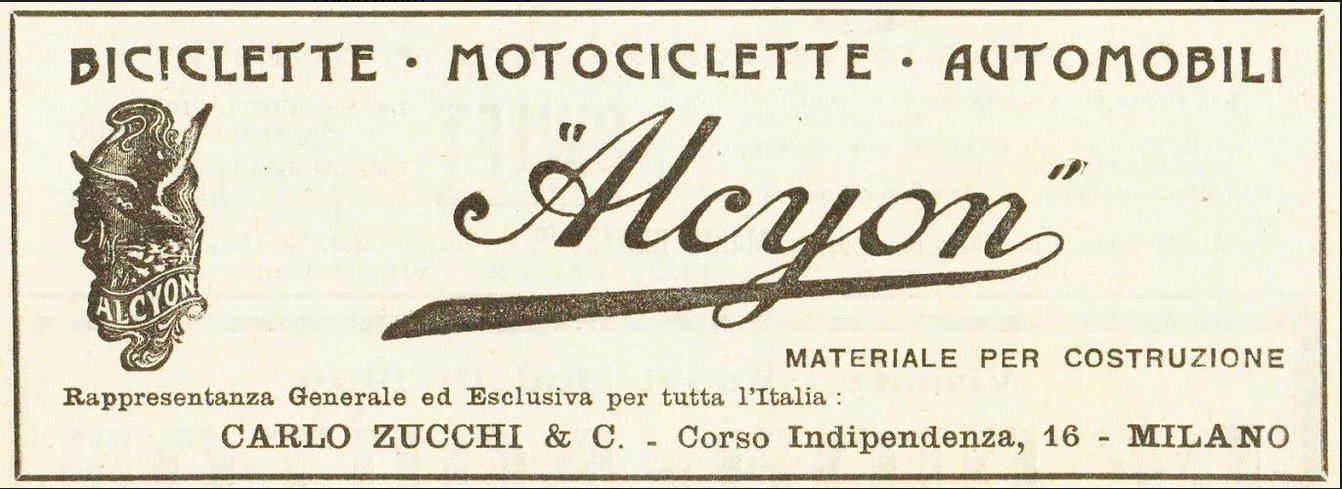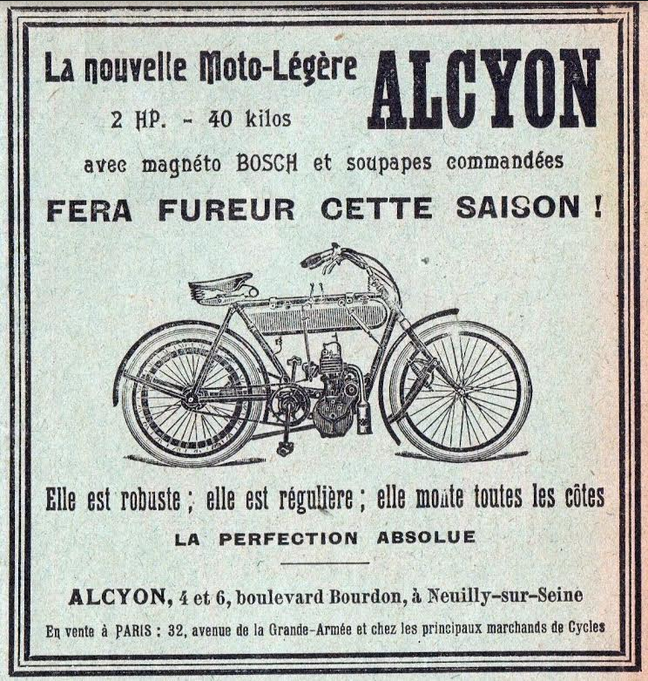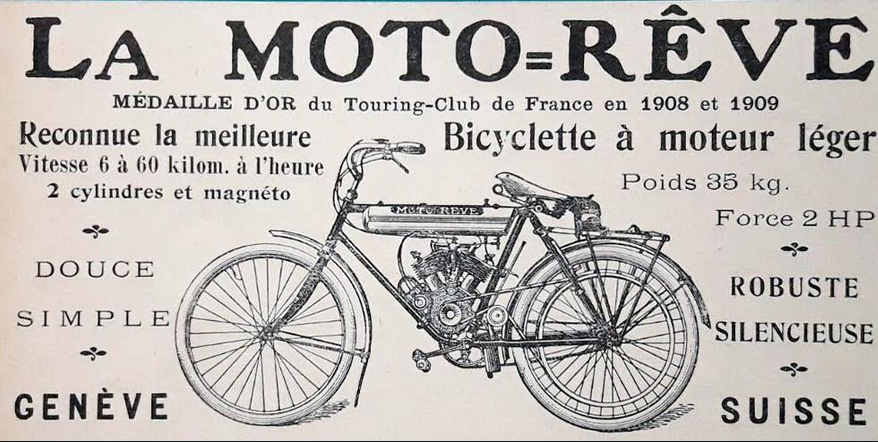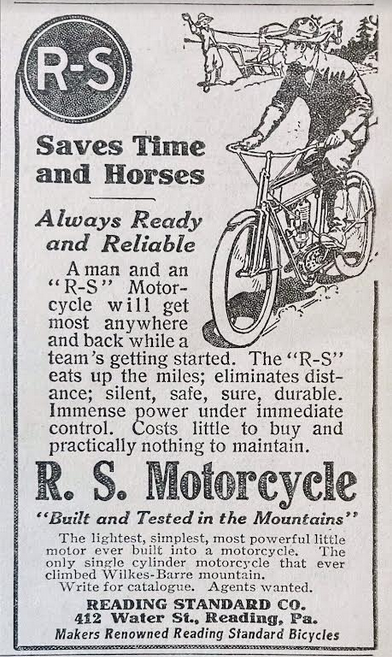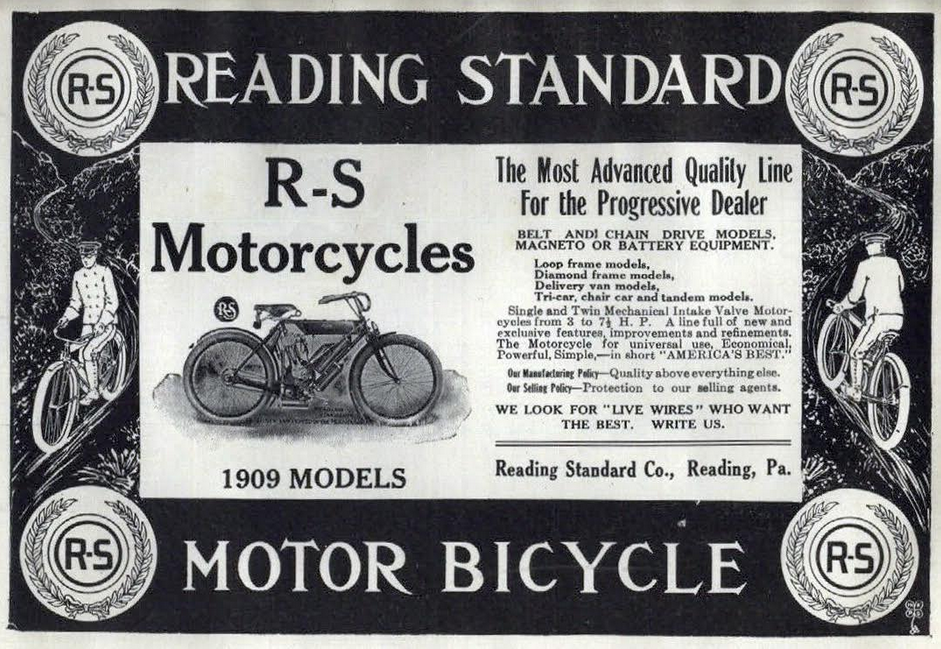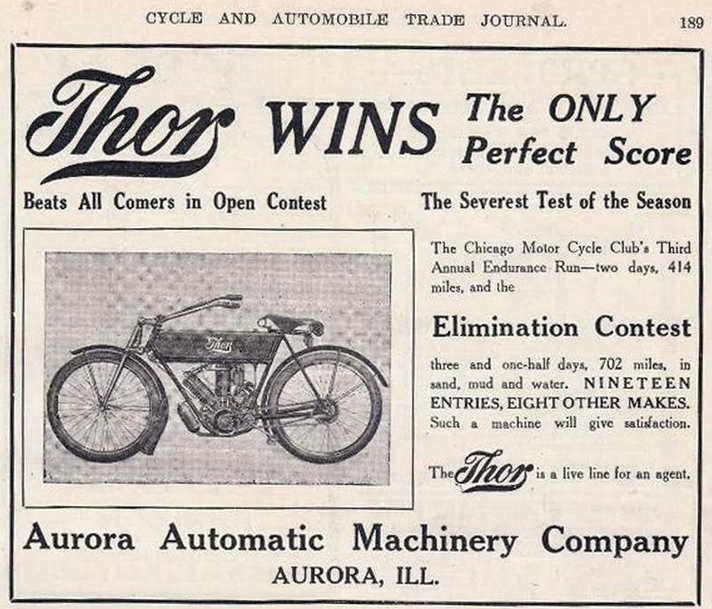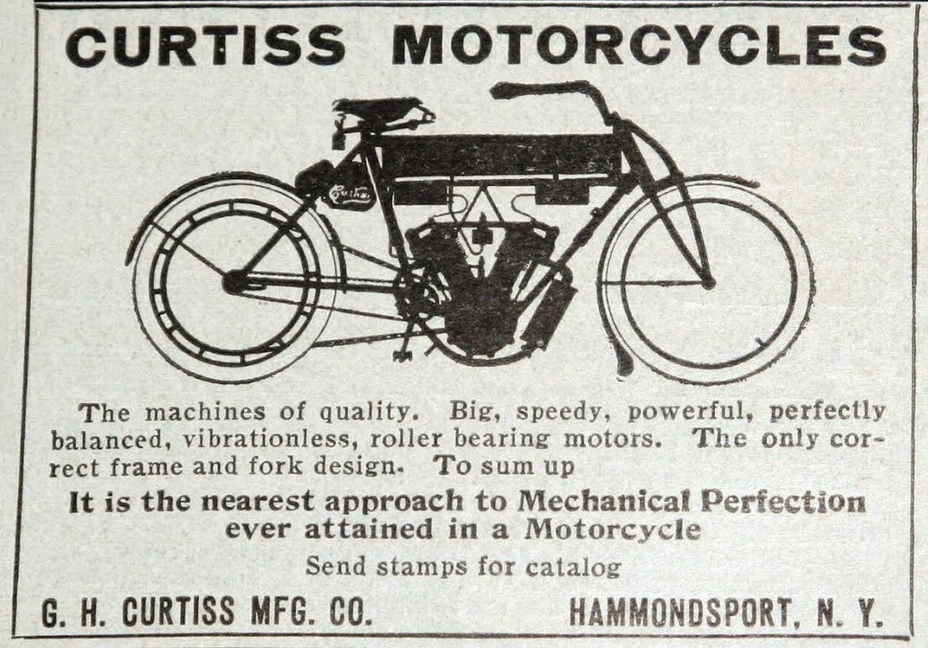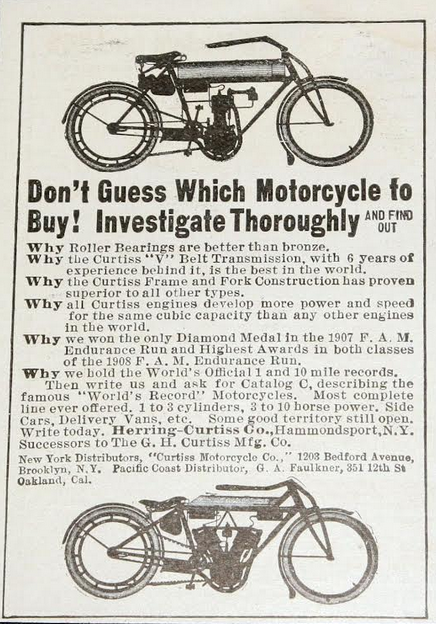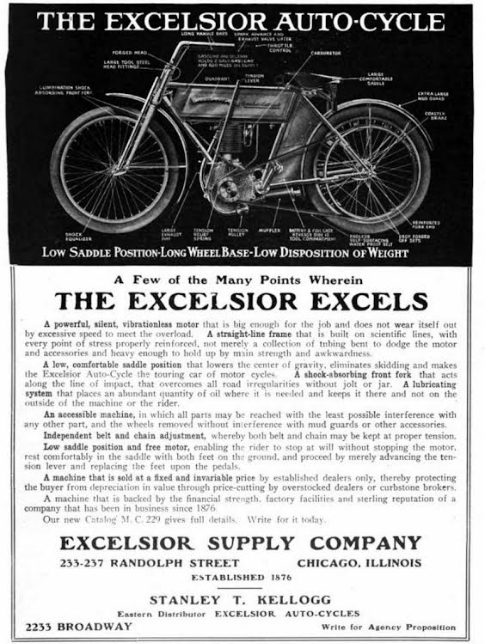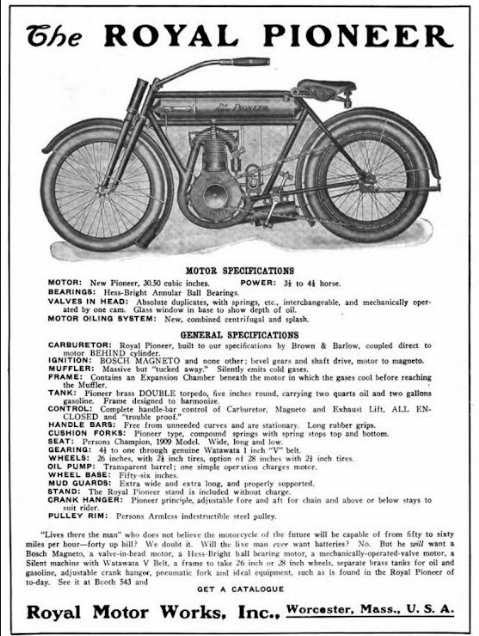A WEARWELL POWERED BY A STEVENS ENGINE completed a non-stop 24-hour run which enhanced the Stevens’ reputation; but Wearwell went to the wall because its company secretary had gambled away its funds at his local boozer. Clyno had begun to use Stevens engines which boosted the Stevens’ income. All of which inspired George, Harry, Jack, and Joe junior to build complete motorcycles. They formed a new company for the purpose and used the initials of oldest brother Jack as the name of their motor cycle. Jack was christened Albert John Stevens, the tank bore the name AJS.
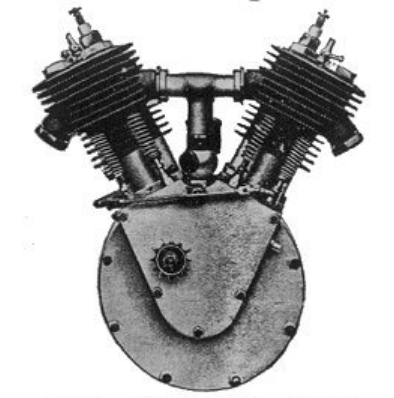
WILL COOKE SET A WORLD motorcycle speed record of 75.9mph on a 994cc JAP-engined NLG. Then he went back to Brooklands with a fearsome 2.7-litre, 20hp JAP V-twin NLG to clock up an unofficial 90mph (there was a problem with the timing equipment). The Green ‘Un reported: “…this fearsome looking machine, mostly engine which takes up all the room where a self-respecting machine would keep its tank, but this monster twin JAP is fed from a small torpedo tank on the top tube; WE Cook, its intrepid rider, told us that he could complete three laps at Brooklands without running dry…Cook said that with fully retarded ignition the spark occurs dead on top of the stroke, and with a view to facilitate timing and tuning up of the cylinders, he has drilled two tiny holes in the
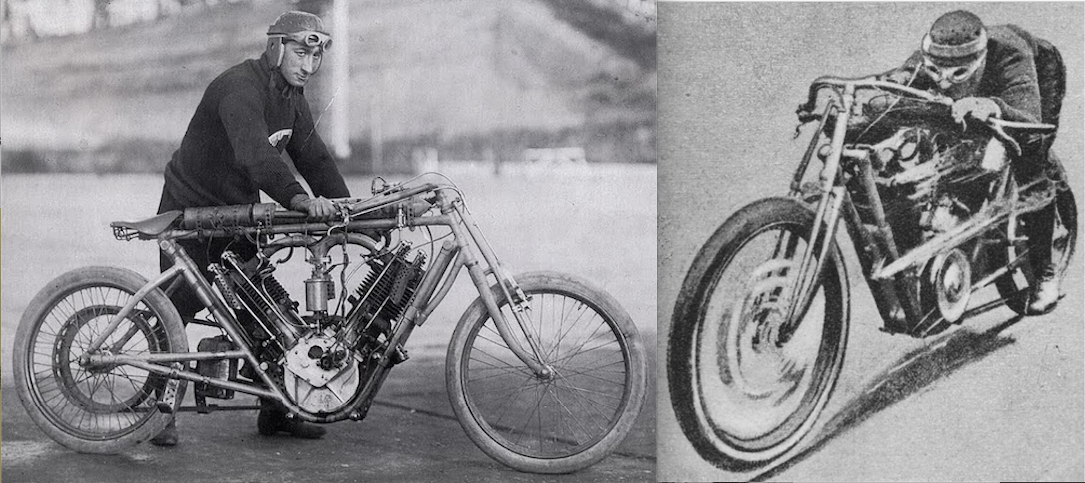
cylinder heads so that a spoke can be inserted when the small plugs are unscrewed…He says the 16-20hp does not keep the track well; in fact he is hardly ever in the saddle when the speed gets up above 70 miles per hour… WE Cook is a cheerful soul, and keeps himself fit for his record attempts by riding a racing pedal-tricycle at weekends…he is a clever amateur artist…he is modest and only with difficulty could we persuade him to give us any account of his doings, but he let fall the pleasing information that should any customers of the North London Garage fail to pay their bills it would be their fate to come out for a spin with him in a side-car hitched up to the 16-20hp. This awful prospect will doubtless extract the long delayed cheque. His head is protected by a special leather healmet strongly padded and coming well down over his ears so that in case of an accident this device should save his head to a certain extent. Other racing motor cyclists prefer the pneumatic helmet strengthened with strips of steel, but it is more than likely, in our opinion at any rate, that if there ever is an accident it will not make much difference whether a man wears a helmet or not.” Cookie had taken a spill the previous year when the back wheel fell off. “Twice, he says, he tried to get up, but found he was still rolling over and over until at last he came to a standstill, badly shaken and bruised, but still alive…On the main line, nearby, the fastest expresses seem to crawl when Cook gets low on his 16-20hp, for have we not seen him crouching low and hurtling though the air at 90 an hour? Like Curtiss in the USA, Cookie was also fascinated by flight – he was reported to be “building a flapping machine for a customer… according to the sanguine inventor, when he sets the planes at 20º and gets the 6hp twin engine to work the flapping apparatus, away he should fly”.
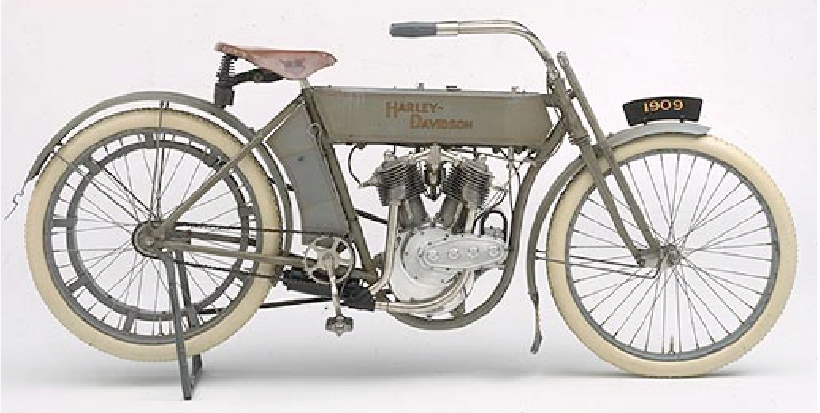
THE BRITISH MOTORCYCLE RACING CLUB was formed; it’s still very much in business and known as ‘Bemsee’.
A 500cc TRUMP-JAP did 48 miles in an hour.
THE BRITISH CYCLE AND MOTORCYCLE Manufacturers and Traders Union was established to run an annual motorcycle show and look after “mutual interests”. Its first president was Sunbeam founder Sir Charles Marston.
“THERE ARE 88 DIFFERENT pattern single-cylinder motor bicycles on the British market; 46 of these have engines with mechanically operated valves, and 61 have magneto ignition as standard. Only two makers use chain transmission, while nine still fit rigid forks. The number of multi-cylinder machines is 72. The lowest-priced machine costs £19 19s, while the most expensive costs £65.
“‘ONE OR TWO MODERN crankcases which I have recently inspected lead me to suggest that it might be a good thing if all crankcases were cast as nearly as possible dead smooth externally. The motor cycle suffers from the opprobrious epithet of ‘smelly’ equally with its big sisters, and a good deal of the smell arises from hot dirt mixed with oil on the exterior of the crankcase. A brand new machine, with an absolutely clean crankcase, seldom leaves any smell behind it.’—A Contributor.”
THE UK GOT A NEW FOUR courtesy of “Wilkinson Sword Co, Pall Mall, W, that old-established firm which has made its now world-wide reputation in the manufacture of swords and bayonets for the British Army”. The water-cooled Wilkinson-TAC (for ‘touring auto-cycle’), like the Pierce four launched the previous year in the USA, was aimed at the luxury market. It was described as “a luxurious two-wheeled mount built on car lines” . The 7hp/680cc engine followed car practice by having not one, not two but three gears operated by a lever in a gate setting a trend that would become ubiquitous
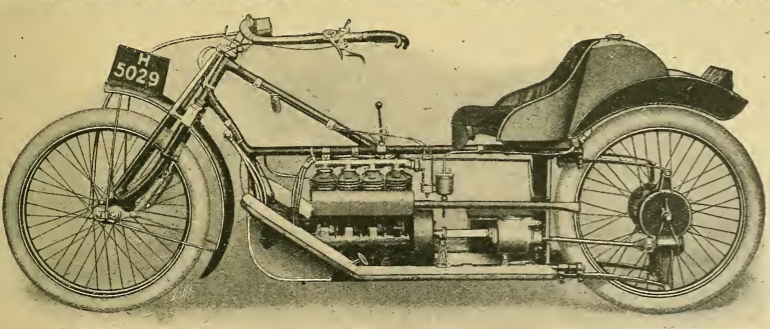
until foot gearchange took over. There were ‘inspection windows’ in the crank to check crankcase oil levels; leaf springs took care of front and rear suspension; final drive was by shaft; starting was by a lever. Fuel consumption was claimed to exceed 60mpg. The forks were made by Chater-Lea, which also began to make
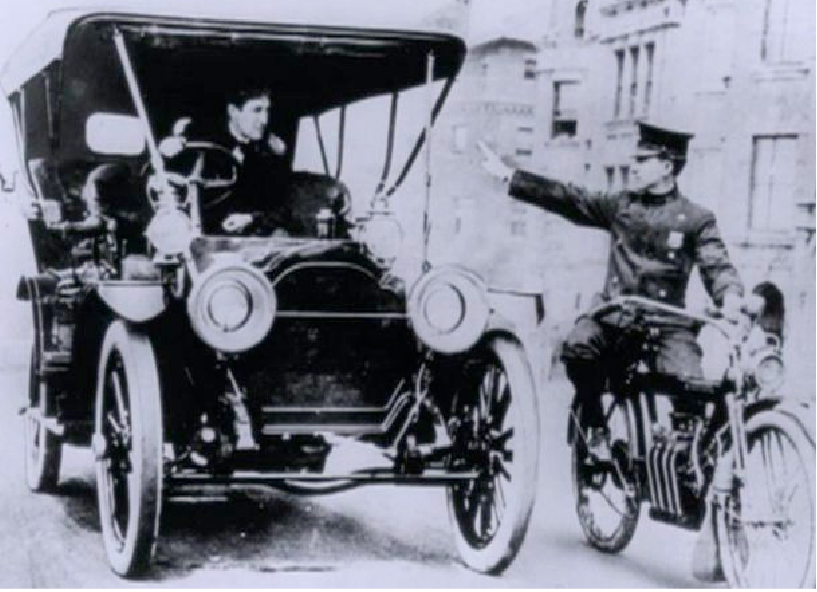
complete motor cycles, as did New Hudson, Blackburn, Regal, Royal Ruby and Premier. Like the Pierce, the Wilkinson was expensive to make; both fours ceased production within four years. While developing its luxury four-pot TAC Wilkinson built a single-cylinder version. The firm was best known for producing edged weapons but had developed a lightweight machine gun which it fitted to the prototype. It would not be the last motorcycle to be built for combat. There’s a contemporary roadtest of the Wilkinson TAC in the 1909 Features pages.
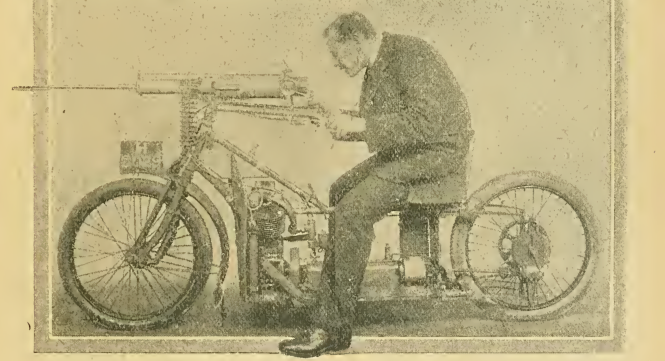
MOTORCYCLING REAPPEARED; IN TIME a green masthead would lead enthusiasts to dub it the Green ’Un. Surveying the size of its potential market the Green ’Un estimated there were 70,000 motorcycles on British roads.
“READERS WILL REMEMBER that the Auto Cycle Union recently announced a series of Esperanto lessons. Esperanto is being taken up by motor cyclists as an assistance when touring abroad and in the hope that some day this language will become general. The following are a few of the principal words: Brake band (bremsorubando). Carburetter (karburatoro). Contact breaker (kontakt-rompilo). Exhaust (gaaforfluo). Exhaust valve (forfluo valvo). Goggles (okulvitroj). Horse-power (cevalpovo).”
MOTOSACOCHE WAS TEMPTING BRITISH riders with a “gentleman’s motorcycle, with spring frame and stand” weighing just 82lb.
“A FOUR-CYLINDER FN motor bicycle was seen towing a superior type of dog kennel on rubber-tyred wheels in St Albans recently. This combination has been has been used most successfully as a dog’s ambulance in St Albans where valuable dogs are kept by certain breeders.”
WITH THE BLUE ‘UN RUNNING A SERIES of stories from doctors promoting the physical and logistical benefits of motor cycling, Dr Innes Dick of Yorkshire sent in a selfie indicating both the hardiness of his locally produced P&M and his own determination to serve his patients in all weathers.
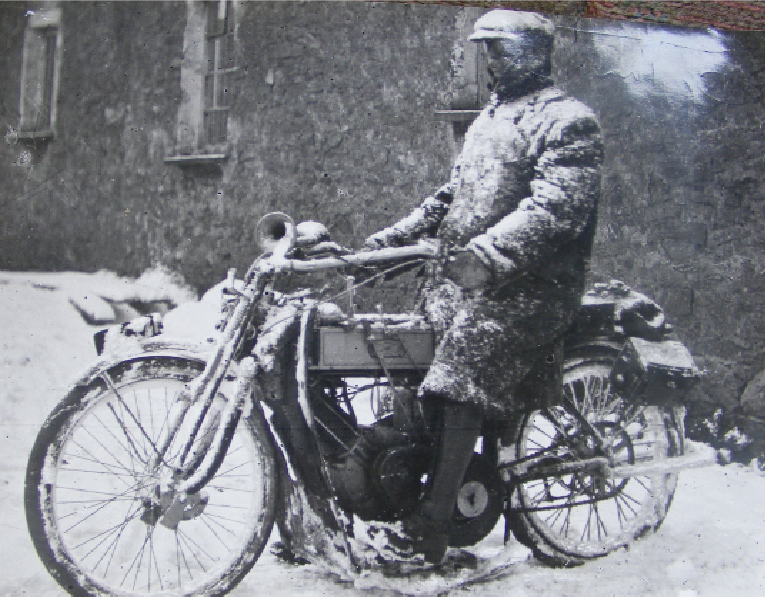
WELCOME TO THE FIRST TEABAG, invented by Thomas Sullivan–so much more civilised than instant coffee (qv), and an essential workshop supply.
BRITAIN IMPORTED £48,327 WORTH of motorcycles and components (up from £45,762 in 1904). But by way of comparison exports were worth £105,554 (up from £38,431).
IN THE USA LEE CHADWICK developed a supercharger for racing cars.
A BINKS CARBURETTOR PIONEERED the use of pilot jets; within a couple of years the company was producing two-jet carbs for motorcycles.
“HA COLLIER CREATED the first 24 hours’ motor cycle record at the Canning Town track on Wednesday and Thursday last. In the time named he covered 775 miles 1,340 yards The longest motor cycle track record previous to Collier’s was the 12 hours’ record made by Azani”. Six years before Alessandro Anzani had covered 434 miles 425 yards at the Parc des Princes Track in Paris with a remarkable V3. And Anzani was still very much in business. Louis Bleriot had just used an Anzani engine for his historic cross-Channel flight and his monoplanes propellor was developed on an experimental ” aero motocyclette’ that Anzani had built in 1906. (The propellor, on the front of the bike sucked it along a Parisienne boulevard at 50mph). A 1909 futurist waxed lyrical: “Will it be possible to attach a flying device to a motor cycle and use road wheels or planes and propeller at will? Time alone can show, but the idea is certainly not wildly impossible, as the Channel flight itself was proved to be an impossibility not long since.” Patriotic Brits smarting at the aeronautical lead snatched by the French were reassured: “It is satisfactory to note that at least one British invention had to be requisitioned to enable Monsieur Bleriot to accomplish his feat. The Bowden wire mechanism, in fact, played a vital part in the control of ‘Bleriot XI’, its flexibility and lightness rendering it peculiarly suitable.”
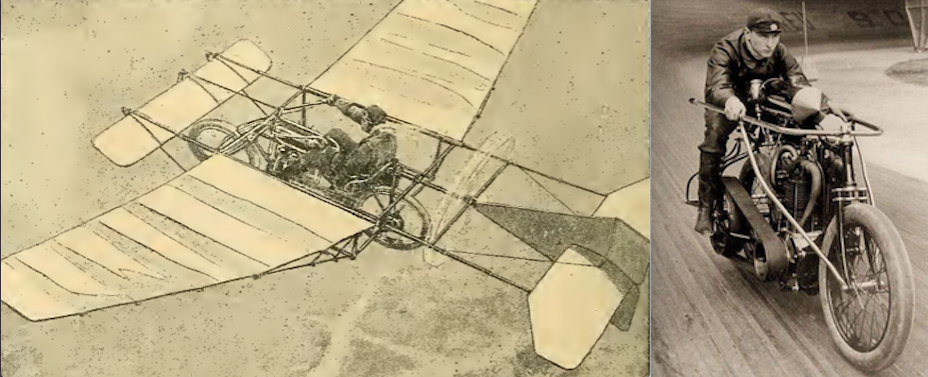
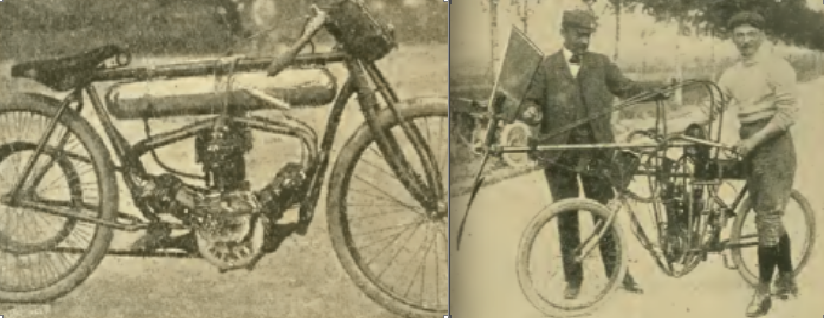
“WE NOTICE THAT THE ORGANISERS [of long-distance trials] have discarded the appearance awards as far as concerns the riders. It is questionable whether this is wise, as it must be patent to anyone that a rider who can keep a smartly attired appearance is the one who has the least trouble with his machine, presuming he is clean and smart at the start. Trouble with belts, tyres, engines, etc, usually means a dirty appearance at the end of a day’s ride unless one has time to stop for the necessary ablutions.”
FA MCNABB SET BRITISH 50- AND 100-mile records on a 484cc sv JAP, covering 107 miles, 1,385 yards in two hours at 96mpg.
BROOKLANDS HOSTED ITS FIRST WEEKDAY meeting (on a Wednesday) with a prize of £25 for a 1,000cc handicap race over 8½ miles. There were 33 starters; Harry Collier (8hp Matchless) took the purse, well ahead of HG Partridge (6hp NSU) and Charlie Collier (3½hp Matchless). Harry’s average speed of 69.75mph was a track record. The Blue’ Un reported: “Although French, German, Austrian, Belgian, and American motor cycles were represented in last Wednesday’s race at Brooklands, an all-British machine scored an easy win.” Following the race WE Cook was doing over 60mph on a practice lap when he came off, but escaped with minor injuries as he was wearing one of the latest leather helmets.

“NO PARTICULAR FORM of ignition can be said to have scored in the four motor cycle events at the Brooklands Easter meeting, for the winner of the Spring Handicap used dry batteries; the winners of the Easter and Surrey Plates, magnetos; and the victor in the Byfleet Plate, accumulators.”
THE MOTOR CYCLE SET OUT to find the heaviest rider in Britain. Step forward WF Cross of Sunderland, a strapping 6ft 1in and 19st 12lb. He had won medals in hillclimbs and speed trials on his 3½hp single-speed Minerva and regularly covered 150 miles in a day. A pundit opined: “That the perfect motor cycle change speed gear has not yet been devised is quite as apparent as the demand for a gear, particularly among heavyweight riders.” History does not record Mr Cross’s view. In any case it was the end of the line for Belgian pioneer Minerva.
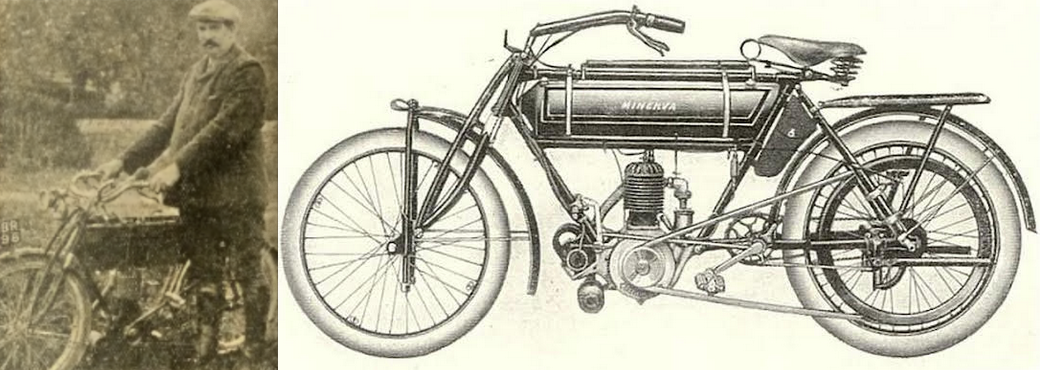
IN JAPAN MICHIO SUZUKI opened a factory producing looms for the silk industry; in Italy Guiseppe Gilera opened a factory producing motorcycles.
MEMBERSHIP OF THE Motor Cycling Club reached 315.
ASL CAME UP WITH AIR-SPRUNG FORKS and an air-sprung cantilever frame; the air shocks could be pumped up to suit the rider’s weight. Two examples were ridden in the London-Edinburgh run, and were said to be “much admired”. FG Smith, who rode one of them, picked up the MCC Challenge Cup for sticking closest to the time schedule.
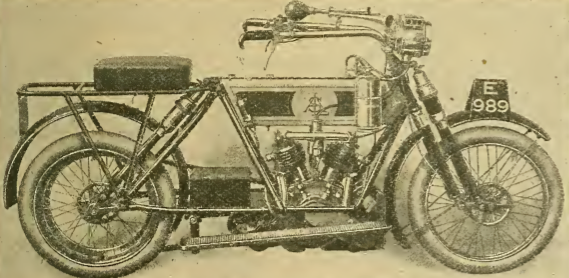
BELGIAN ACE OLIESLAGERS successfully defended his title at the Brussels Velodrome for the sixth year running–after 10km he finished just 50 metres ahead of rising star Andre.
NEW YORK’S NEWLY ESTABLISHED corps of motorcycle cops, with the approval of their commissioner, held a race meeting. The Motor Cycle commented: “In England it is hard to imagine our constables and sergeants taking part in track races. Were there motor cycle policemen in this country, there would undoubtedly be less persecution, the real road hog would be wiped out, and the careful drivers would be free from molestation.”
IVAN B HART-DAVIES RODE his 3½hp Triumph from John-o’-Groat’s to Land’s End in 33hr 22min, knocking 7hr 16min off the previous End-to-End record. Soon after Vivian Olsson and Charles Talbert claimed the first End-to-End ‘passenger motor cycle’ record of 65hr 14min on a 7hp Vindec Special (VS) with a Mills-Fulford fixed wheel sidecar.
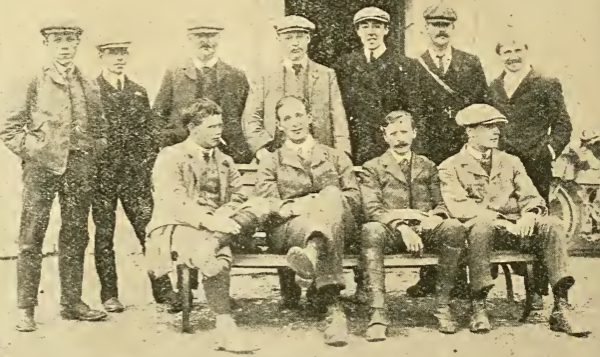
Meanwhile, on t’other side of the Irish Sea, CE Murphy (3½hp Triumph) completed an Irish End-to-End in 13hr 6min, breaking his own 1907 record by 2hr 42min. Within a month of Olsson’s record it was reduced to 59hr 7min by Arthur and Horace Bentley on a 5hp two-speed Rex and Millford sidecar. Just six weeks after the Bentley brothers took the End-to-End record from Vivian Olsson it was taken again. Martin Geiger and William Lamm made the run on a 7hp Vindec Special and Mill-Fulford sidecar in 51hr 45min. You’ll find the full story of the long road from John-o’-Groats to Lands End, as well as six-day and coastal treks, replete with tales of derring-do and sheer British pluck in the 1911 Features pages.
THE MAGISTRATES AT SYDENHAM fined a motor cyclist £3 (equivalent to about £300 today) for doing 5mph over the limit down Shooters Hill. On the same day a man who admitted trying to cut his wife’s throat and to trying to strangle and burn her was released after he promised not to do it again.
A NEW PRODUCT WAS DESCRIBED as “a twisting handle grip which has been designed to operate a wire controlling carburettor or magneto. Around the outside of the bar is coiled a wire as shown which is secured by soldering. The slide to which the controlling wire is attached is caused to move backwards or forwards by rotating the handle.” Yes, it’s a twistgrip!

IXION WARNED: “MODERN ENGINES are naturally rather thirsty, and so the supply does not go as far as it used to. But I cannot help thinking that any genuine roadster should carry sufficient petrol to cover at least 120 miles of flat road at 18mph. Makers might meet the objection by listing a larger tank as an extra.”
INLET AND EXHAUST VALVES were getting bigger in the quest for power. Riders were advised to carry spares as the larger heads were more inclined to snap off, and to remove their valves and check them every 1,000 miles.
THE MCC OF NEW SOUTH WALES held a hillclimb at Baden Hill, Coogee. There were a dozen competitors; top three places went to 3½hp LMC, a 2½hp JAP, and a 5hp Peugeot.
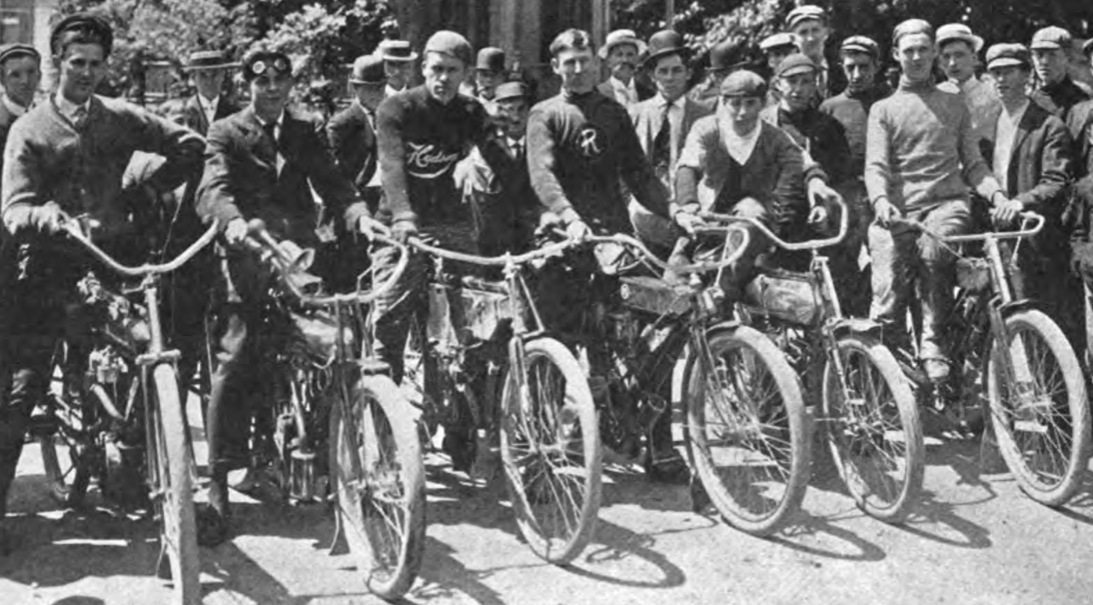
DURING A VISIT TO WALES by the Motor Union and the Ligue Internationale des Associations Touristes speed trials were held on Pendine Sands. The bikes were standard roadsters from 33-601cc; winner was WE James (Oxford) ahead of ET Strick (NSU).
THERE WERE 74 STARTERS in the ACU Six-Days’ Trial including factory teams from Douglas, P&M, Bat, Rex, Humber, Triumph, Premier and Bradbury. They left London (Uxbridge to be exact) on Day 1, riding to Shrewsbury via Oxford. Day 2: circular tour via

Wenlock, Stourbridge, Evesham and Ludlow. Day 3: circular tour via Welshpool, Llanfair, Mawddy (for an observed hillclimb) Aberystwyth and Newton. Day 4: circular tour via Llangollen, Balo, Festiniog, Llandudno and Chester. Day 5: circular tour via Market Drayton, Macclesfield, Cat and Fiddle, Derby and Crudington. Day 6: Shrewsbury to Uxbridge via Much Wenlock, Kidderminster, Worcester, Gloucester, Birdlip Hill, Maidenhead and Slough. Here are some highlights: “Seen from the summit [of Dashwood Hill] a huge batch of motor cyclists climbing in close order presented an interesting spectacle…in places steam rollers were at work effecting tardy repairs and considerably hampering the riders…At Tetsworth, RW Walker (3½hp Premier) had a short circuit in his magneto, and in Oxford met further misfortune, being thrown from his machine by a
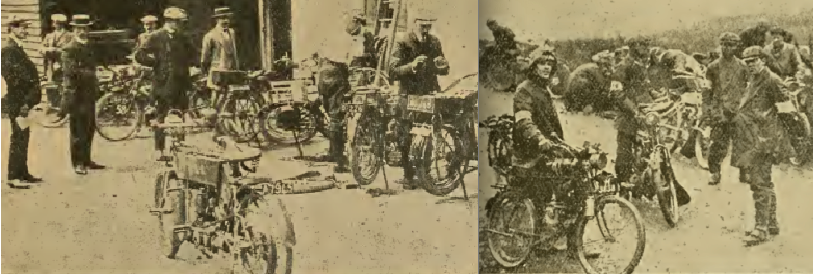
dog on Magdalen Bridge…At Worcester Phillips’s 3½hp Scott, which had been the centre of attraction since the start, suffered a series of punctures from a nail [he was forced to retire]…Several of the riders complained of nails being strewn on the road near Shrewsbury. Those picked up were new, and consequently people are unwillingly inclined to be suspicious…The lunch and attendance at the Swan Hotel were all that could be desired, but a charge of 3d garage for each machine was met with by righteous indignation on the part of the competitors, and their resentment at one time nearly assumed serious proportions. It then began to rain, and to save further unpleasantness the men paid and tried to look pleasant…Edmond (3½hp Humber) was among those who had belt trouble; while the Roc and sidecar (carrying the only lady in the trial) has experienced a broken frame, which probably means its retirement…A strong wind blowing down the course made matters as bad as they could be, and, added to these adverse conditions, the tops of the mountains became covered in clouds, and rain soon began to fall heavily…Some dozen of the remainder failed to make the ascent, and the

Rex and sidecar shed its passenger…To my astonishment, I met BH Davies with his tank empty walking towards Dinas Mawddwy, the reason being that he had been wrongly directed by a policeman…For 52 miles the route lay along Telford’s magnificent road, probably the best graded in the British Isles…Gradually the road deteriorated into a mere mountain track, the milestones only indicating that it led to anywhere in articular…At Cerrig-y-Druidion I met Andrews (2hp Moto-Reve) in tow of the GWR motor omnibus. He has stripped some teeth off the magneto driving wheels, and was out of the competition, so I took charge of him and towed him towards headquarters. Near Chirk I came upon Pershke (6hp Puch and sidecar) hopelessly broken down through magneto trouble. With the aid of Andrews’s Watawata and a strap I took him also in tow and brought them safely back to Shrewsbury…The 5hp Rex and sidecar driven by Lord was driven 120 miles after an encounter with a ditch. I saw the machine, and marvel at Lord’s grit in sticking to his mount. The front forks were twisted all on one side, but Lord quickly straightened them, and, although the front tyre was practically rubbed through, he succeeded in reaching Shrewsbury at a somewhat late hour…All the morning the roads

had been magnificent, but from Birdlip on they became very rough and full of holes almost the entire way to Uxbridge. Outside Cirencester I passed Lee-Evans (Indian) in trouble by the roadside, and later on learned that he had suffered a seized piston and retired… Holdroyd, the rider of the Motosacoche, was received with vociferous cheers when he entered the Chequers’ yard on Saturday. They were deserved, as the little machine really distinguished itself…The thanks of all those concerned in the trials are due to all those chief constables through whose districts the routes passed. Not a single case of police interference was reported, though several of the areas traversed are reputed to be by no means free of traps. In many cases the police were of valuable assistance… Stanton’s retirement was due to ill-luck. By some unaccountable means his lubricating oil tank was filled with what was afterwards discovered to be ‘varnish’ although it was poured from a Vacuum tin…Altogether there have been 26 retirements, and 48 have come through successfully…The Trial has certainly been the most arduous ever held by the Auto Cycle Union, and probably it will result in the 1910 machines being vastly improved.” The survivors picked up 31 ACU gold medals, 16 ACU silver medals and two ACU certificates. The ACU team prize went to P&M; TH Tessier (7hp Bat-JAP) won Miss M Hind’s Cup (best performance by a twin). AJ Wilson’s Cup (best performance by a lightweight) went to WW Douglas (2¾hp Douglas twin); MJ Schulte’s Cup (best performance by a single) went to FC Mustard (3½hp Triumph).
THE ACU’S COUNTERPART OVER THE POND, the The Federation of American Motorcyclists, staged its eighth annual ‘endurance run’ as part of a weeklong national conference which also included track racing, a formal dinner, parade, election of officers and a day at the beach. The endurance run was described beforehand as “the most notable motorcycle contest ever held in the United States” and afterwards as “the most successful in the history of motorcycling in the United States”. The two-day, 362-mile run from Cleveland, Oregon to Indianapolis, Indiana attracted 103 entrants;
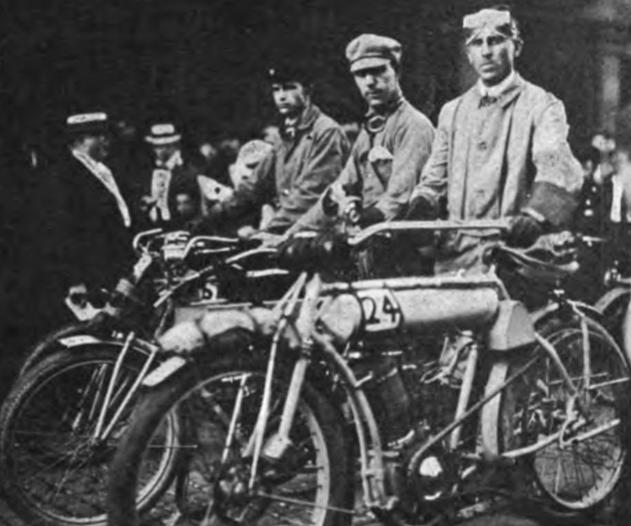
96 riders on 19 marques started: Curtiss (1), Emblem (4), Excelsior (5), Harley Davidson (7), Indian (21), Kiefler (1), Marvel (1), Merkel (7), MM (3), New Era (3), NSU (6), Pierce (3), Racycle (1), Reliance (5), R-S (15), Thor (8), Torpedo (1) and Yale (4). They were started in groups of four at one-minute intervals and to ensure compliance with local speed limits, had to average 15mph on the first section, riding to 17mph and then to 19mph for the final dash. As with ACU trials, there were test hills to contend with. An observer reported: “The journey was characterized by very few accidents. About one dozen riders went into ditches, but serious damage did not result…Farmers drove wagon loads of sightseers to points along the course and stationed themselves beneath shade trees; others placed chairs in front of their homes and children waved flags, while all along the route the greeting was uniform and profuse…Some parts of the roads were so bad that the riders were forced to dismount and walk their machines through the deep sand. This, of course, caused them to increase their speed as soon as a clean stretch was found. Pedestrians and travellers cleared the track and gave them the right of way, driving into the ditches in order not to hinder the prize-seekers…the dust rose in clouds wherever a rider was making much more than 10mph… many minor accidents were caused by blinded men running into deep ruts, over culverts and into roadside ditches or failing to notice sharp turns ahead…one rider

made a complete somersault with his machine and then continued on his way as though nothing out of the ordinary had occurred…the boys made no attempt to ‘burn up the town’ upon their reaching Columbus…very few were to be found outside their rooms after nine o’clock…the riders spoke in profane terms of the wretched roads between Coshocton and Newark…cheer after cheer sent the contestants on rejoicing…The machines were taken from the exhausted men at the checking station by members of the Idiana Club and pushed to the Cadillac automobile garage, half a square away, where they were housed under police vigilance…” Gold awards for perfect 1,000-mark runs went to 38 riders; 26 either failed to finish out finished more than two hours pas the deadline (one with a wooden ‘cage’ fitted by a blacksmith to hold his frame together).
TWO DAYS OF RACING AT THE NEW Indianapolis speedway were to have been an integral part of the FAM programme of events; it had been “widely, not to say wildly heralded” as a record breaking track. Indianapolis was the world’s second purpose-built, banked oval racing circuit after Brooklands; with and the first to be called a ‘speedway’. With a permanent seating capacity of 257,325 it is now the highest-capacity sports venue in the world. But it didn’t get off to a smooth start: “The huge track, the immensity of which one must prove by personal visit in order to appreciate, failed most dismally to materialize.” The state of the track put off most of the entrants for the 10-miler for professionals–in the
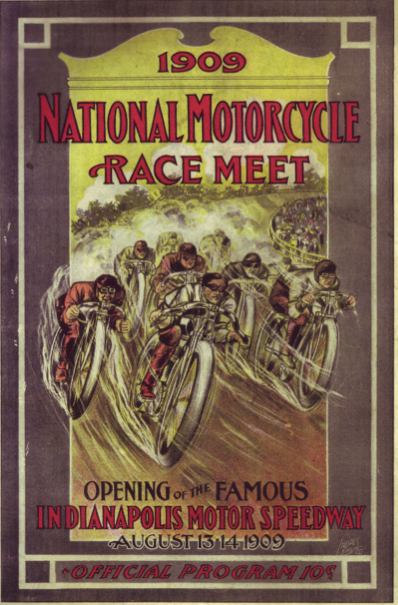
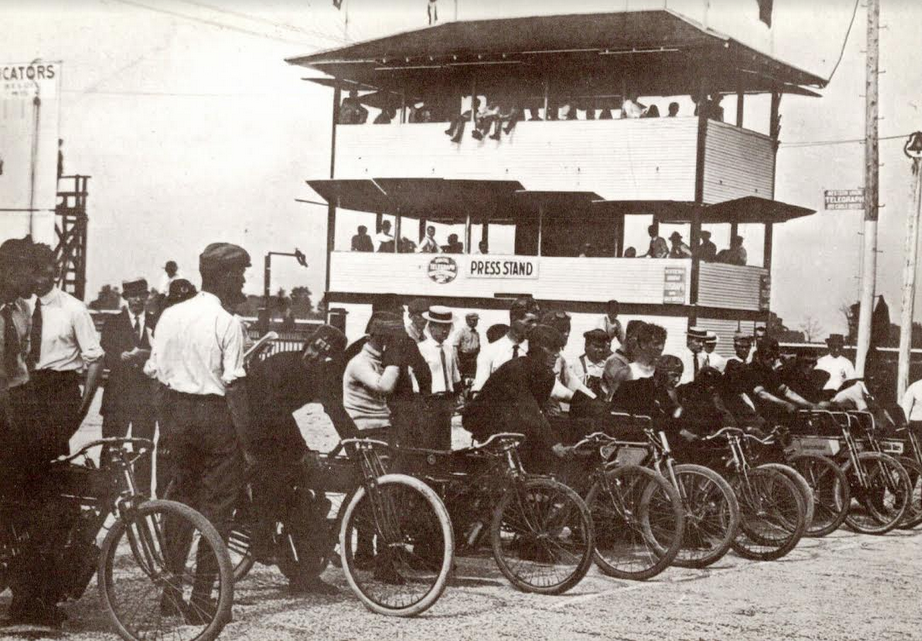
event it was a head-to-head between Jake de Rosier (Indian) and Eddie Lingenfelder (Thor). They gave the crowd a great show until “de Rosier’s machine hit a depression in the track. His front wheel was twisted and his tire ripped off. The champion fell in a cloud of dust. He had been going at the rate of 60mph… a hasty examination showed not only scratches and bruises but also a painful and organic wound necessitating an operation and certain to incapacitate him for the duration of the season…it is quite probable that he will never ride again in his old-time form.” Six other races went ahead that day with reduced entries but the riders got together to discuss the state of the track and called of the second day’s racing was cancelled.
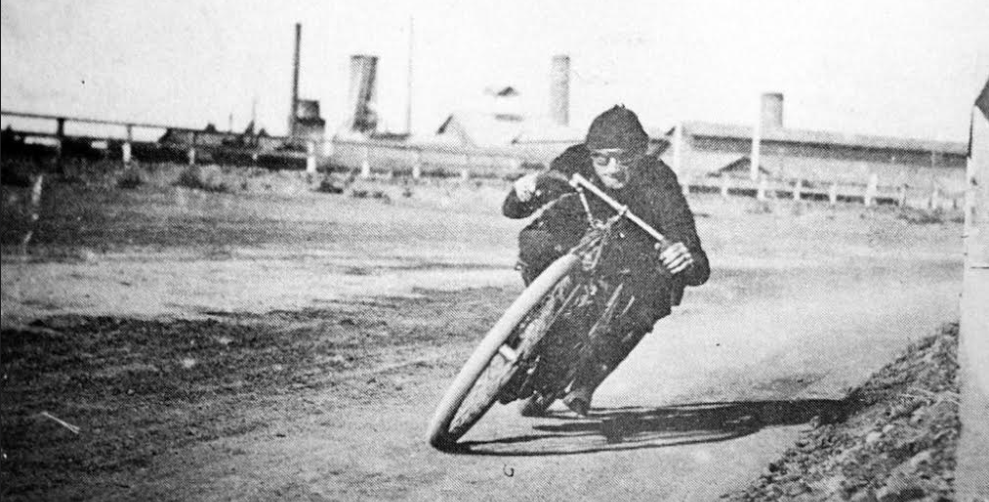
SOME CYCLE PACERS WERE TANDEMS with two-man crews: one to steer, the other to control the engine. One such machine crashed over the safety barrier at a brand new banked wooden velodrome in Berlin when a tyre burst at more than 50mph. As it landed in the crowd its fuel tank exploded. Several spectators were burnt to death, many more were injured. The German authorities suspended motor cycle pacing of cycle racing.

“THE ROADS IN THE NEIGHBOURHOOD of Coventry are notorious for what are called ‘potholes’. In some districts these are filled up with tar and stones and rammed in, but outside the borough of Coventry we have never noticed any attempt to fill up these holes properly.”
THE EDINBURGH MCC’S FIVE-DAY reliability trial to John-o’-Groat’s and back attracted 26 starters. “The roads were indescribably bad for practically the entire distance of 176½ miles between Inverness and Thurso, and the competitors reached their destination draggled and plastered with mud from head to foot. Probably no competitors in any motor cycling trial have ever had to face such an exacting journey.” One long downhill section boasted two emergency escape roads, one with a 20% upward slope to stop runaway vehicles. By the end of the five days and 768 gruelling miles six bikes had dropped out; only two won gold medals for perfect scores: HH Salvesen and SJK Thomson, both on 3½hp Triumphs.
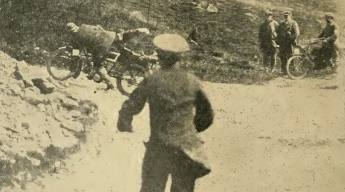
NO LESS THAN 17 CLUBS entered teams in the MCC’s Inter-Club trial. The MCC won, ahead of the Coventry and Warwickshire and Oxford MCCs.
THE ACU CONDEMNED SUNDAY events and by no means all of its members agreed. The chairman of the Western District MC commented: “Surely the affiliated clubs are at liberty to hold competitions (not ill-climbs or races) without the grandmotherly legislation of he ACU, and I am of the opinion it is exceeding its powers. Our members are nearly all employed in offices or are in such a position that they cannot take Saturdays just when hey choose, and even when two o’clock comes there is lunch, change, getting home, and getting to the rendezvous, this all means time. Now how is it possible, after allowing for contingencies, say, to make a start at five o’clock and run off a 200-mile reliability trial in schedule time? It is unreasonable. These supporters of our competitions are after all the ‘live’ members. The sooner the ACU rescinds such ‘silly’ resolutions the better, otherwise, my club seriously contemplates withdrawing its support. We feel very angry in this matter.”
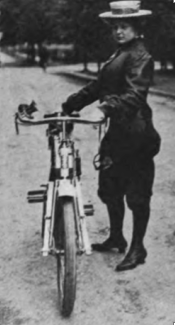
THE ACU’S ATTITUDE TO THE LORD’S Day might explain why the MCC ran its 24-hour reliability trial on a Friday and Saturday, rather than over the weekend. Exactly four hours were allowed for each of six laps from Taplow to Oxford and back, making a total of 450 miles. Riders had to keep to an average of 19mph. One mark was lost for every 15sec ahead of or behind schedule. The local garage rigged acetylene gas lamps to illuminate the overnight control and arranged petrol supplies. Harold Karslake (‘nondescript’ won the silver cup, with Hugh Gibson (3 1/2hp Triumph) a close second.
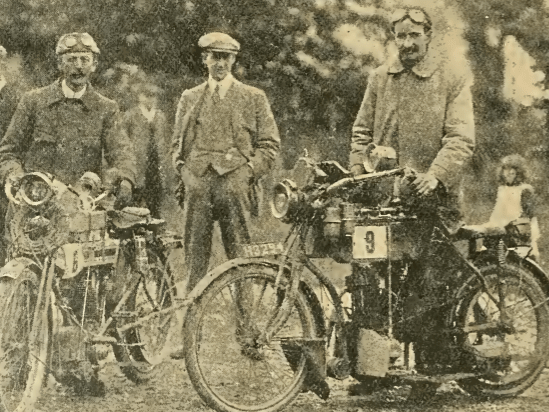
Karslake subsequently paid a handsome compliment to Gibson: “I feel that some recognition is due to Mr Hugh Gibson for his very sportsmanlike behaviour…he was only two marks from me on the losing side after the third round, and stood a very good chance of winning, as he had a much better watch than I. Yet on the two last rounds he was sportsman enough to give me the exact time five miles from home, so that we should both have an equal chance as regards time. It is such instances as this that promote the good fellowship which exists amongst motor cyclists, and I cannot find words to express my admiration. I may perhaps mention that I had only met him once previously, when on the last London-Edinburgh run we rode together from Stamford to Edinburgh. It may interest your readers to know that the machine I rode has done nearly three years’ hard service, and has done about 18,000 miles without once failing me. The only adjustment during the trial was to replace two links in the Whittle belt at Oxford on the fifth round. I think it is safe to claim that this is as little as any other competitor did to his machine.” [Karslake had only just joined the MCC. Years later he recalled: “I was invited to a MCC
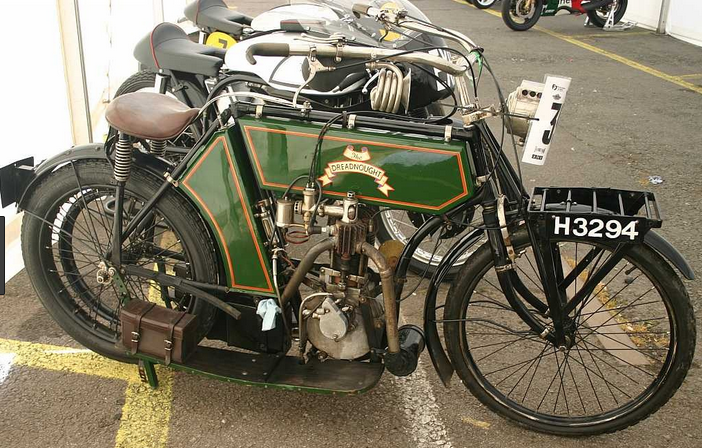
Smoking Concert, and although I did not know a single person there I was made perfectly at home. I was so pleased with the boys that I decided to join them.”] His ‘nondescript’ motor cycle was The Dreadnought, built to his own design. She survives to the present day and is ridden on the Pioneer Run by Vintage MCC members in his memory. Mind you, not everyone was so happy with the trial. A local doctor wrote: “Might I suggest that the next time the MCC hold this trial it favours a route where it does not cover the same ground twice during the night. I live on the Henley-Oxford main road and was kept awake the greater part of the time by the machines roaring through the village with their cut-outs open. I should not have minded if they had only come through once. I am not an anti-motorist, as I ride a motor cycle and drive a car.”
THE ACU SET UP THE AUTO CYCLE LEGION, “with a view to placing at the disposal of the War Office a body of motor cyclists able to take an intelligent part in the defence of their country in a time of national danger”. ACL ‘commands’ were quickly established in London, Essex & Suffolk, Bradford, Manchester, Oxford, Glasgow, Kent and Reading. The Army did have some motor cyclists within its ranks. Stanley Glertson (9hp Bat) and John Dale (3 1/2hp Triumph), both members of the Middlesbrough &DMCC, were attached to D Squadron of the Yorkshire Hussars. Their adjutant described the motor cyclists as the most useful men in camp. More riders were encouraged to join the ranks of the Territorials. A ‘Technical Reserve’ was established, including “members of the medical and veterinary professions, civil engineers, and especially electrical engineers, railway and telegraph personnel, the owners of motor cars, motor cycles, balloons, aeroplanes, etc, [who could] render service of the greatest value.” The Blue ‘Un, under the heading ‘Wake up England!’ warned: “Many foreign countries long ago recognised the utility of motor cycle despatch carriers, and have for some years employed squadrons of motor cyclists in military manoeuvres.” Both Germany and Austria had well organised groups of riders who were being used in military exercises.
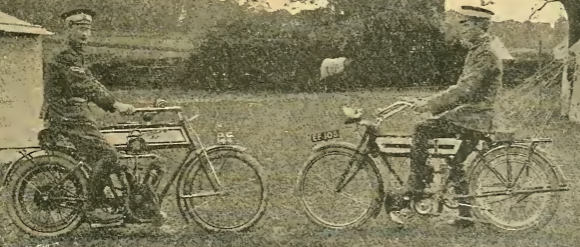

THE BIRMINGHAM AND OXFORD MCCs went head to head in a climb up Irondown Hill, near Deddington, Oxon. Each club fielded six of the best; the Brummies recorded an easy win. There were few spectators because Irondown Hill was an open road so they kept the contest quiet.
DECADES BEFORE THE FORMATION of the first sidecar club a group of ‘passenger motor cycle owners’ (sidecar outfits and forecars) met at Stratford-on-Avon “to compare notes on fitment in the way of gears, lamps, and tyres.” In the event 13 combos and forecars turned up, had a good time and determined to make the get-together an annual event.
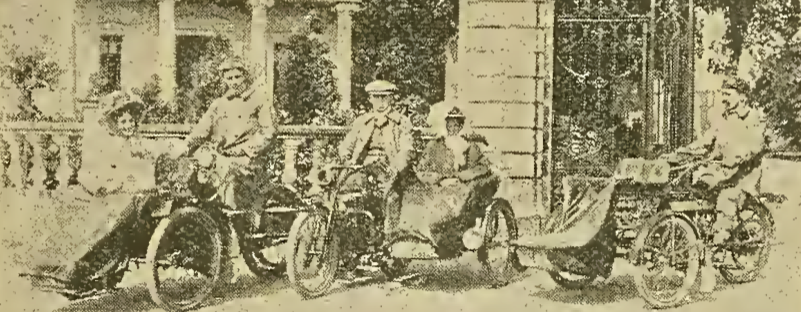
IXION MADE A CRI DE COEUR: “The bulk of the riders of to-day are still young, dashing, athletic, vigorous, and mechanically-minded. But amongst them there remains a strong leaven of us old stagers who have lost a portion of our old dash and agility and daring. We now leave to others the thrilling dash round the bend of a fearsome hill, with the wall of the tyre where the tread should be, and the left or right ear tipped over sideways till it nearly fouls the bumps on the road. We are not quite so powerful at heaving a machine off its mark as we used to be, not quite so graceful in vaulting into the saddle as the impatient engine gathers way. We do not dive in between a couple of carts or two
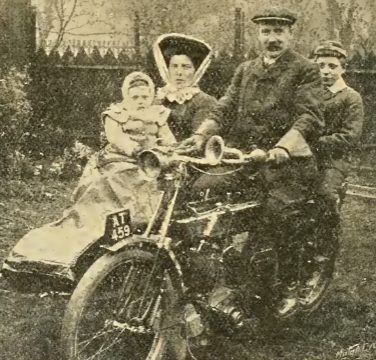
suspicious bullocks half-way up a steep hill with the old verve and aplomb. We are liable to streaks ot lumbago across the small of the back after 200 miles in the saddle, to touches of cramp in the fingers and wrists after they have gripped a steel bar for a day and a night. We want machines even more docile than the present handle-lever-controlled tourist mounts; we want a less gymnastic mode of starting; we want the engine to start us up a grade, instead of our having to start it; we want to be able to potter up the long curly ascent when the roads are slimy, strewn with traffic, and so forth; we want absolute, not comparative, freedom from vibration; and we want a lot of other things we dare not ask for yet.”
A POLICE INSPECTOR TOLD A COURT in Bedworth, Warks that he intended to charge every motorist who exceeded 6mph in the town centre. The Motor Cycle commented: “Motor cyclists should note this statement, as their only course in future appears to be to dismount and walk through the Market Square. Those who are acquainted with the town of Bedworth will not consider, it a particular hardship to avoid the place altogether unless important business necessitates a visit.” Eeeeew…
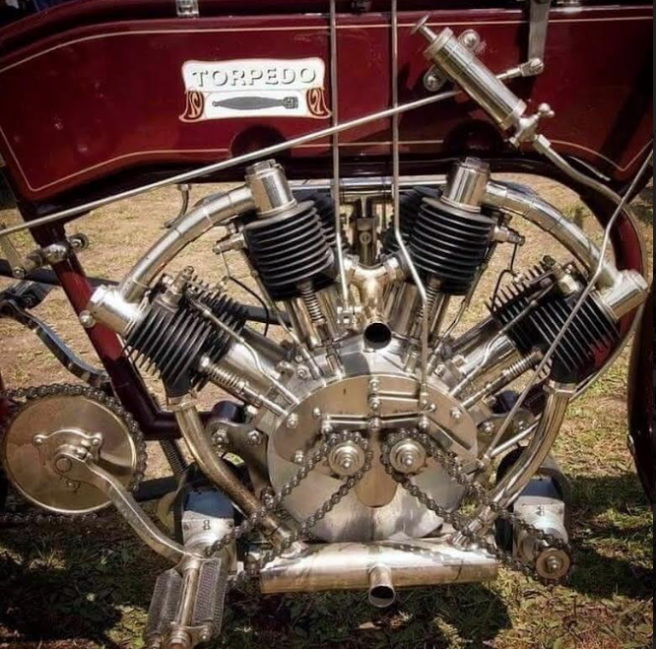
GEORGE DE WALD OF BROOKLYN. who claimed to have built the first in a series of shaft-drive bikes in 1901, finally got his ideas ito production with the SD (for Shaft Drive) Manufacturing Co. The SDM debuted at the New York motor vehicle show in Madison Square Garden, one of three new marques among the 19 on display in the basement area dubbed ‘Pneumonia Alley’. It was not the first shafty on the US market (the Belgian FN in-line four arrived in 1905; the Pierce that it inspired in 1909). But the SDM was the first single-cylinder shaft-drive motor cycle in the USA. It incorporated a patented multi-plate clutch as an engine shock absorber to “overcome the shock and vibration in vehicles propelled by explosive engines, more especially motor cycles, incident to the firing of the charge when the motor cycle is first started or after it is started when the load is very heavy, as when climbing a hill”. The SDM was rated at 3½hp (490cc) and 4hp (499cc) with a choice of battery or magneto ignition and it could be “equipped with spring fork if required”. A dentist named EA Gainsford bought a SDM at the Madison Square Garden show and covered 2,200 trouble-free miles in 10months, reporting: “The transmission is surprisingly smooth, and when called upon, the machine alway provides a continuous powerful pull…And I find it a pleasure to rub the road dust and dirt from a smooth tube rather than to keep a belt or chain in proper trim…”I know that a great many people are skeptical of the shaft drive when applied to a single-cylinder engine, but I can only say to them that the shock absorbing device applied by the said manufacture has rendered me a service that I am grateful for.”
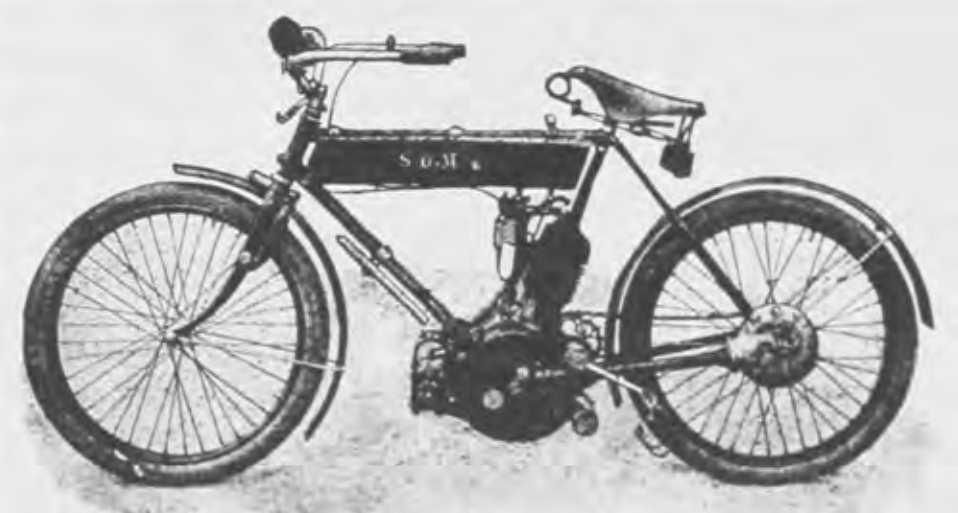
“It has been again suggested that in all programmes of race meetings not only should the hp of the engine be mentioned, but also the capacity in centimetres. The variation in the capacity of motor cycle engines is certainly very marked, for machines of 3½hp vary from 400 to 499cc, and 5hp twins vary from 600 to 750cc.”
BROOKLANDS WAS BEGINNING TO REFER to motor cycle capacity rather than horsepower. In a 5½-mile handicap race for bikes from 350-750cc the first six riders home were on two 5hp Indians (of 616 and 638cc), ‘scratch’ while a 743 (4hp) NSU was given a 20sec start, a 449cc Rex, 40sec; a 476cc Triumph, 45sec; and a 482cc Zenith (48sec). The first three home won £7, £3, or £2 with the option of trophies for riders who preferred glory to cash. The handicapper was congratulated for ensuring close racing. G Lee-Evans (638cc Indian took the £7 at an average 60.5mph followed home by AR Evans Jnr (Triumph) and JC Smyth (Rex). Also-rans were W Dewar (Triumph), JT Bashall (WHB), FA McNab (Trump-JAP), AG Fenn (Triumph), AP Applebee (Rex), DF Steeves (NSU), ECW
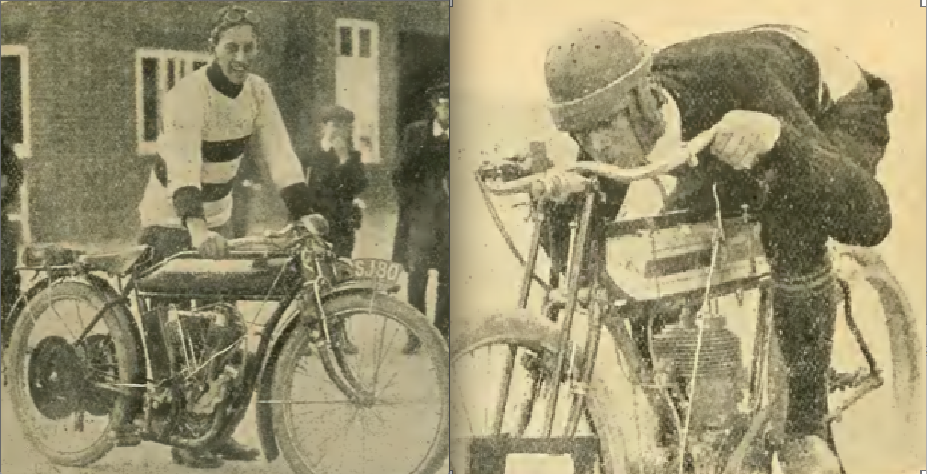
FitzHerbert (FN), OC Godfrey (Rex), SF Garrett (NLG) and PW Bischoff (FN). Lee-Evans went home with a pocketful of sovereigns; he and his Indian won five races in all, including the Senior (500-1,000cc) and Roadster, for bikes up to 1,000cc in full touring spec including mudguards, two brakes, proper silencers (no cut-outs to be used) and toolkits weighing at least 3lb. The big boys were out to play too in the eight-mile Championship Cup (up to 1,000cc). JAP’s latest 20hp twins were clearly the order of the day. First and second spots went to Charley Collier and HV Colver, (both on 964cc Matchlesses) followed by LC Munro (995cc NSU), HE Parker (944cc NLG), Harry Collier (964cc Matchless), WE Cook (944cc NLG) AND WH Bashall (964cc Bat). Charley Collier’s winning speed was 69.25mph.
THE LEEDS MCC WERE ABOUT to start their hillclimb at Otley when a local resident asked them to find a new venue as his wife was ill and needed to rest. The clubmen willingly complied and a local bobby told the club’s officials of a suitable hill at Norwood Edge, about five miles away. The new venue was found to be a tough one and the Leeds boys had a jolly good time climbing it. JS Garrett (3½hp Rex) won, followed by four 3½hp Triumphs, another Rex and another Triumph. The grateful resident promised to present the club with a trophy for a future competition.
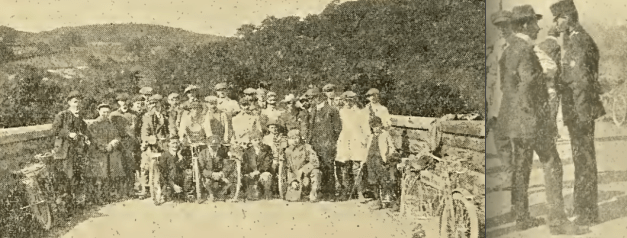
THE US STATES TYPICALLY ENFORCED speed limits of 8-15mph in urban areas and 20-25mph in the countryside. However, Arkansas, Georgia, Idaho,Maryland, Mississippi, Montana, Oklahoma and West Virginia and Wyoming had simply ignored motorcycles: no registration, no licence and no speed limit. The Federation of American Motorcyclists’s legal committee published suggestions for ‘ideal’ motor cycle regulations including a 30mph speed limit and allowing a rider from one state to ride in another state for up to seven days.
IN THE FIRST HALF OF THE YEAR Germany’s motor cycle imports fell from 209 to 99 as exports rose from 1,013 to 1,116.
FG SMITH (3½HP TRIUMPH) won the MCC’s Edinburgh and Land’s End trials, matching the success of SG Frost the previous year.
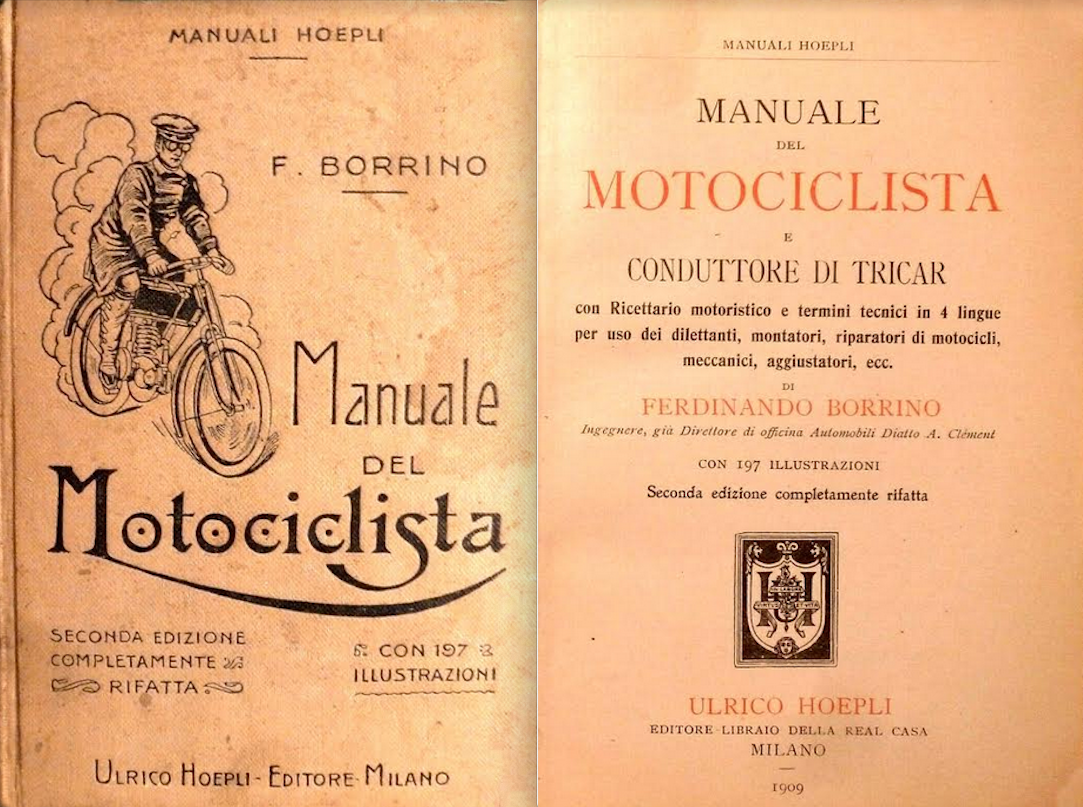
“WE ARE SORRY TO NOTICE a growing tendency to make use of the rear carrier for the purpose of carrying a passenger, and trust it will not become abused.”
WILLIAM DOUGLAS, ONE OF THE two brothers behind Douglas motor cycles, had a busy year, competing in most of the major events on his lightweight 2¾hp flat twin to good effect. In the ACU quarterly trial he earned a 100-mark certificate; ACU 24hr Plymouth trial, silver medal; ACU Sutton Bank Hillclimb, runner-up; MCC 48hr Edinburgh trial, special gold medal; ACU 1,000-mile trial, silver cup and gold medal; Scottish five-day trial, bronze medal; MCC 555-mile Land’s End trial, gold medal.
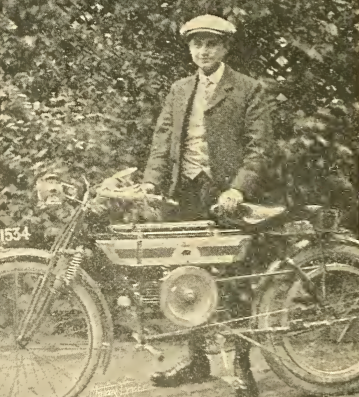
THE BERLINER ELECTRIC TRIKE made, as the name implies, in Germany, was launched onto the UK market by the Swan Electric Traction Company as the Swan runabout. The front wheel was driven by shaft from the motor over the front wheel; the 120amp/hour battery pack mounted behind the two-seat body was claimed to give a range of 50 miles on average roads. The mudguard took the place of conventional front forks with spring-steel bars to give at least some suspension. This was very much an urban runabout with a design cruising speed of about 15mph though higher speeds could be delivered in small doses at the expense of range. A van body was available as an option.
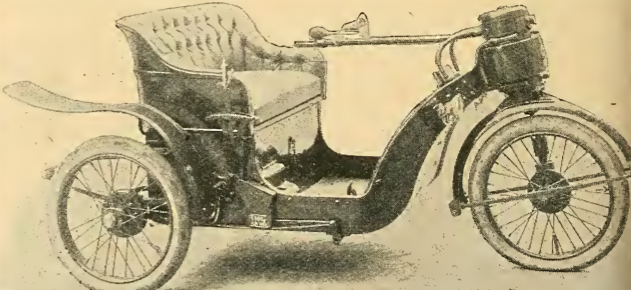
THE REPORT OF THE COVENTRY and Warwickshire MC’s third annual open hillclimb was headlined ‘The Zenith Gradua has a Day Out’. Six awards were up for grabs and Graduas took five of them on the handicap formula (though Guy Lee Evans rode his Indian like a demon to record the fastest climb of the day).
ENCOURAGED BY THE SUCCESS OF INDIANS in England, Hendee set up a depot in London’s West End, almost next door to the FN, NSU and Vindec Special depots: “Before attempting to introduce the Indian into England, it has been deemed best to first demonstrate its capabilities before the English public, although in the 1907 and 1908 Six Days’ Trials of the ACU the Indian ridden by Mr Hastings, won two gold medals for reliability and the special prize for best appearance at conclusion of the trial. It is now history that the two Indian motorcycles which have been in constant use, both in track and road competitions, have secured more awards this season than any other two individual machines of other makes, although almost invariably having competed against machines of much larger cylinder capacity.” A pine-board track opened in Springield, Indian’s home town. It measured 5,767ft 8in (measured 18in from the inner rim) and was claimed to be the fastest in the USA. F Huyck duly tried it out on his 7hp Indian–in an hour he covered 71 miles 620 yards; en route he set a 50-mile record of 41hr 49.6sec. In a mile trial with a flying start Huyck cut the record from 45.6sec to 42.6sec. Jake de Rosier, in a standing-start mile
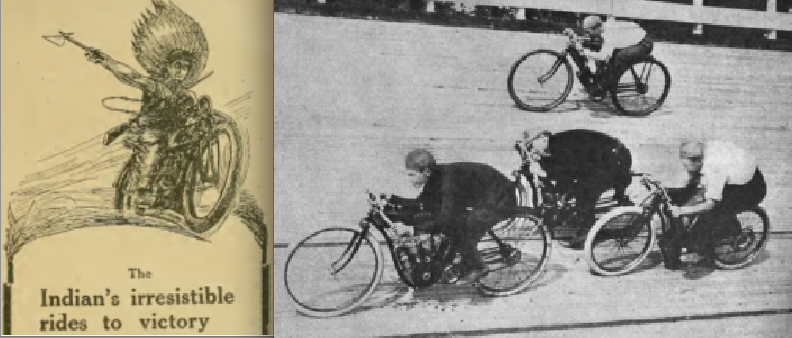
trial, cut the record from 47.2sec to 43.2sec and, in the 25-mile professional race, cut the seven-mile record from 21min 38sec to 20min 13.4sec: “Away and beyond all other men on the track shone De Rosier, of the graceful physique, and with all the tactics of a racetrack general.” Chas Gustafson took his Indian to Springfield to cover 300 miles 1,174 yards in six hours. Chas Spencer (also on an Indian) did 559 miles 587 yards in 12 hour and kept going for 24 hours to cover 1,093 miles 199 yards; Gustafson managed nearly 1,044 miles. This was way ahead of the 775 miles 1,340 yards recorded by Harry Collier on what the Yanks referred to as the ‘Cannington’ track. All these records were sanctioned by the Federation of American Motorcyclists. Elsewhere in the US R Seymour (Reading-Standard) went record breaking at the Coliseum Motordrome in Los Angeles. He completed four miles from a flying-start in 3min 17sec and went on to set seven, eight and nine-mile records at 5min 45.8sec, 6min 35.8sec and 7min 25.2sec respectively. Eddie Ligenfelder (7hp NSU) set records at two miles, 1min 38sec; six miles at 4min 50.8sec, seven miles at 5min 38.2sec, eight miles at 6min 26.6sec, nine miles at 7min 15.8sec, 10 miles at
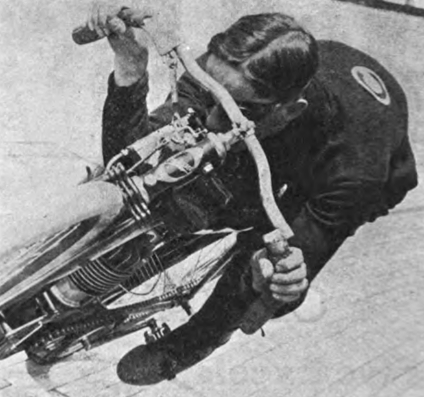
8min 6.8sec and 15 miles at 12min 28sec. Jake De Rosier began racing 100-mile record trials there but it was MJ Graves who rode his Indian into the long-distance record books, covering 100 miles in 1hr 27min 49sec, beating de Rosier’s record by 11min 10sec. Nonetheless, Jake’s popularity was such that promoter and board track builder Jack Prince hired him to race at the opening of many of the board tracks that he was building across the country. There was some controversy over the tracks themselves: “Some Rochester [NY] men are thinking of building a motorcycle track. They claim that a six-lap [to the mile] track will save land and lumber; but it will not save life. A six-lap [to the mile] motorcycle track is a death trap. If the Rochester men build a six-lap track they should be indicted for murder in the first degree at the first killing, because premeditation could easily be proven.” But there’s no doubting that the American Eagle was eager to go beak to muzzle with John Bull. “Now for an affiliation with the ACU, and international competition,” said the US FAM. “We confidently feel that the Briton has absolutely nothing on us. Let us have an opportunity to prove it.”
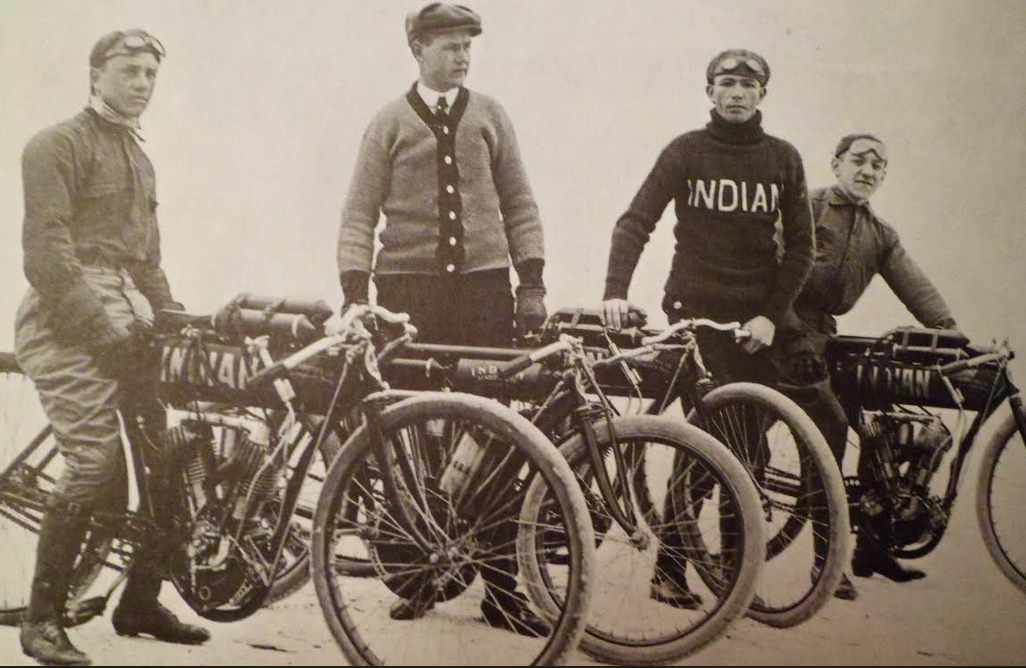
THE ACU DECIDED TO RECOGNISE records set by motor cycles up to 275cc, 344cc, 500cc, 750cc, 1,000cc and unlimited. It had previously only recognised records set by bikes up to 76x76mm (345cc) and unlimited. The ACU’s competitions sub-committee got the ball rolling by listing the record speeds over a measured miles at Brooklands, the UK’s fastest track (giving speed to no less than three decimal places instead of the previous system of fifths of an mph): 275cc, GL Fletcher (274cc Moto Reve twin), 45.447mph; 344cc, not yet set; 500cc, HH Bowen, 482cc Bat single, 64.283mph; 750cc, G Lee-Evans (638cc Indian twin), 64.702mph; 1,000cc WE Cook (944cc NLG twin), 75.678mph.
HENRYK WEISS PUT REX ON the Polish map by winning the 178-mile Motorcycle Championship of Warsaw in 5hr 2min 43sec. The runner-up was another Rex that crossed the line 37sec behind him.
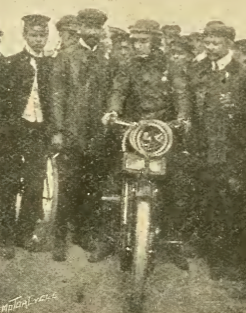
“THE SOUTHAMPTON BENCH LAST WEEK fined their own fire brigade captain for driving the town’s motor fire engine at thirty miles an hour. The captain urged that it was necessary for him to practise driving at this speed. It would be rather provoking to the magistrates if, supposing one of their residences caught fire, the fire brigade captain refused to do more than crawl to the scene of the conflagration.”
THE WINNER OF THE NOTTINGHAM &DMCC petrol consumption trial, riding a 3½hp Triumph, managed 211mpg.
A SIX-DAYS MOTOR CYCLE RACE was arranged at Brighton Beach, New York. Nine three-rider teams had entered; five started. Many thousands of spectators were expected; 500 turned up. It began to rain so after 11½ hours they all went home. At that point the New York MCC team was leading, having covered 599 miles, 19 miles ahead of the Harlem club.
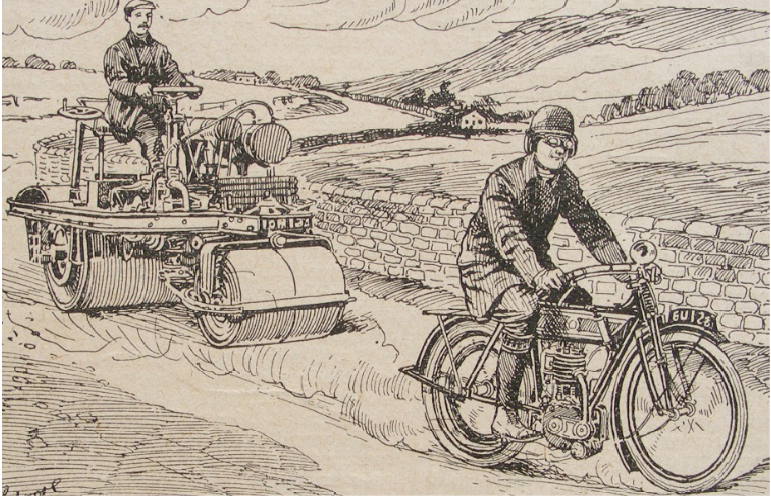
IN ITS PREVIEW OF THE THIRD TT the Blue ‘Un noted: “Several of the twin-cylinder machines are only 1cc short of the limit. Truly this is cutting it fine. It means that if both the cylinders have worn a hair’s-breadth by the end of the race, the capacity of the engine will exceed the limit…Nearly all the machines appear to be sound and sensible mounts, and the freak element is entirely absent…The Indians, the Scott, and one or two of the Triumphs were wonderfully quiet…From Peel to St John’s it is again bumpy. It is a great pity the Highway Board has no steam roller, as without it a really smooth surface cannot be obtained.” There was no limit on fuel consumption and the singles and twins, limited to 500 and 750cc respectively, ran together. Clerk of the Scales was BH Davies. Well they couldn’t run a TT without Ixion. He was asked for his TT predictions: “Beyond doubt it was Marshall’s corner work which greatly helped to return him a winner last
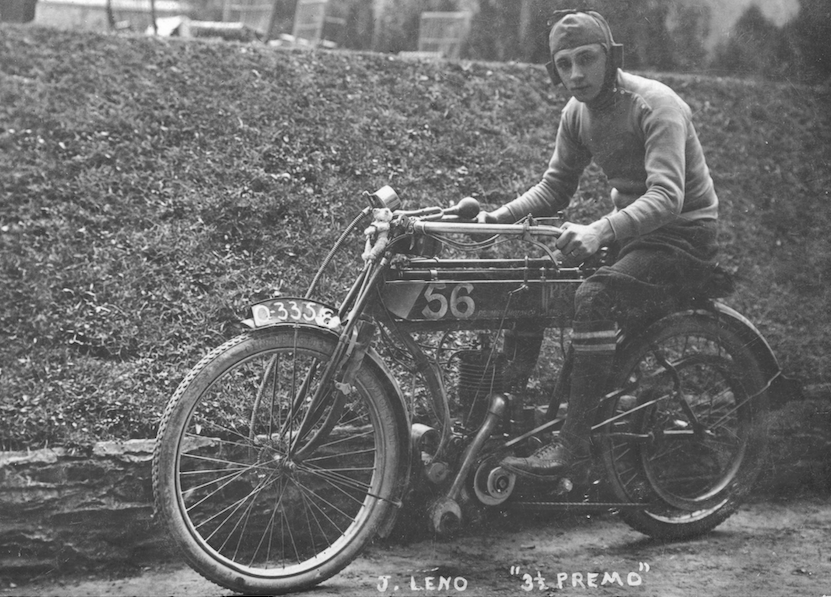
year. The course bristles with corners, and the man who can negotiate them without losing a possible second is the man who, other things being equal, will win. The only newcomer in whose favour I shall venture to make a reservation is Giuppone. None of our men can teach him anything at the racing game, whether in tuning or steering or nursing; and I have heard a very good account of the new 84x86mm (476cc) Peugeot engine. Of course some of our trade cracks are getting on in years, and as years increase a man necessarily parts with some of the reckless aplomb which leads him to take sporting risks 50 times in an afternoon. But Marshall, Collier, and Co are as young-hearted as ever they were, and if some amateur in his teens does display a bit more daredevilry, I think superior experience will beat him. My tip is to keep an eye on the old stagers.” A contemporary observer gives a flavour of the big day: “The brakes were tested; the men being required to pull up or nearly pull up at a given signal between two points…such a crowd as has never before assembled at the Auto Cycle TT lined the road in the vicinity of St. John’s…After the last trainload of spectators had arrived the last trainload of spectators had arrived from Douglas and Colonel Freeth, Chief Constable of

the Island, had completed a tour of the course to see that all was in order, the word to go was given, and Marshall (3½hp Triumph) and Reed (3½hp Dot-Peugeot) leaped into their saddles at 10.22, their engines firing at once. Despite the high compression used on many of the engines, it was remarkable how easily they started…the performance made by the Scott was so splendid that the crowd could not refrain a cheer. At the words ‘Get ready’ Myers (3½hp Scott) stamped on the starting pedal, and the Scott fired at once; at the word ‘Go’ he was moving away in the saddle, before the man starting with him had hardly begun to run. It served to show the public how a motor bicycle should be started. The men were sent off in pairs at half-minute intervals. As soon as the last man had been sent off the crowd settled itself down to watch for the first arrival, and here and there people sat in advantageous positions on the grass. Hardly had they done this when a policenan’s whistle blew loud and shrilly. Who was it? Eyes were strained and necks craned forward to catch a glimpse of the rider. Was it Marshall or Reed? Marshall had kept his place, but Lee Evans on the red Indian, who started number seven, had leaped up to second place in order, and was travelling at a great speed…Next in order passed Drury, (5hp JAP) Reed travelling slowly, Godfrey (3½hp Rex) going well, and Wells (5hp Indian), who stopped and retired as he had hurt himself in mounting the previous day, H Collier travelling at a great rate…Sproston (5hp Rex), who to everyone’s astonishment removed his left boot and threw it on the ground…Even at this early stage there were several retirements [including] Carter who retired through a puncture at Glen Helen (irreparable as he had no repair outfit)…” Lee-Evans (5hp Indian) took the lead by the end of the first lap ahead of Harry Collier (Matchless-JAP); by the end of lap two Marshall (Triumph) was in third place. And that’s how it stayed through laps three, four and five, six when Lee-Evans stopped for petrol and oil. Collier took the lead and Marshall moved up to second place. Marshall was gaining on Collier when a snapped exhaust valve and
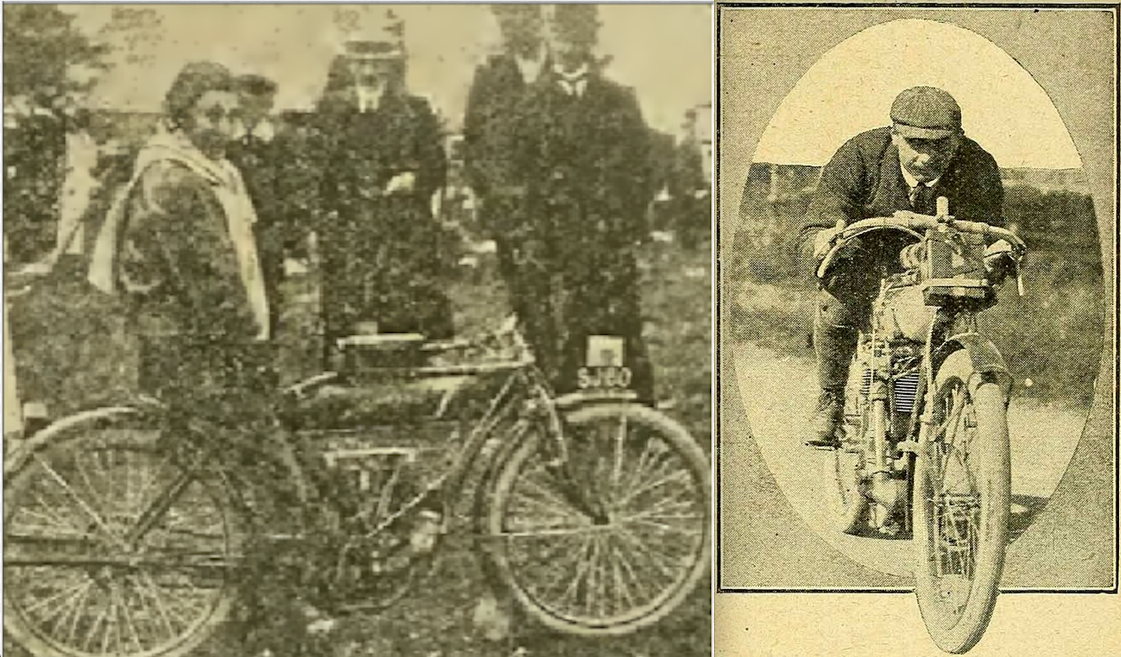
timing gear trouble stopped his Triumph. That left Collier and Lee-Evans to cross the line 1st and 2nd; following a close race Newsome (3½hp Triumph) snatched 3rd place from Godfrey. Giuppone on the Peugeot could do no better than 12th (his engine misfired the whole time, and he lost his silencer on the first lap); Rem Fowler, on a Rex rather than his Norton-Peugeot, was 16th. James Lansdowne Norton (3½hp Norton) retired on the last lap with a lubrication failure. Collier’s winning speed was 49.04mph though he did manage one lap at 50; 1st, 2nd and 6th placed riders were on twins; 3rd, 4th and 5th were on singles and Marshall was on course to win on his Triumph single–the debate about singles vs twins was not resolved. There was no lack of drama, as the man on the spot noted: “Naturally, as there was no limit to petrol consumption this year, the times were vastly faster, and naturally tumbles were more frequent. No one, however, experienced serious injury, which speaks well for the riders’ skill.” It also put extra strain on the bikes. There were 54 starters (“in allotting the numbers, the fateful 13 has been omitted”); 28 singles, 25 twins and a four. Only 19 completed the course within the time limit; 11 twins and eight singles. Sproston finished 19th but “his arrival was greeted with vociferous cheering, as, despite several punctures, he had gone through the race with a broken ankle bone through catching his left foot between the footrest and the ground when turning sharply on the bridge between Peel and St. John’s.” Gibson (3½p Triumph) retired on the 9th lap but also deserved a medal for detrmination. His fuel tank came off and he crashed at Kirk Michael on the first lap. His exhaust lifter came adrift; his brake jammed on; ran out petrol on the 5th lap, bought some paraffin at a cottage near Kirk Michael and ran on that. He lost his filler cap, his tank sprang a leak, so he bought more paraffin (twice). Leaking paraffin shorted his high-tension wire. Finally, the leak became so serious he gave at Kirk Michael on the last lap. Lee-Evans and his Indian came close to a win but in the event a Collier brother on a Matchless did it again with Marshall’s Triumph in 3rd place British pride was saved, particularly with Giuppone, the Continental ace, and his Peugeot coming 12th behind two Matchlesses, three Triumphs, three Rexes, a Premier and a Bat. An American reporter confirmed Oscar Wilde’s

aphorism that “the Americans and the British are identical in all respects except, of course, their language” when he concluded his report on the TT race: ”…it will be interesting to see if it in its turn can lick the British cracks”. As if that bruiser of a TT wasn’t enough, it was followed by not one but two hillclimbs . One was a six-mile climb up Snaefel where, for the first time, TT competitors encountered the bends familiar to generations of fans as Ramsey Hairpin and The Gooseneck: “Snaefell, the venue of the climb…is generally regarded as the most severe test to which motor cycles have yet been put, excepting, perhaps, the French Mont Ventoux hillclimb…Back to the man on the spot: “Seventy-five entries had been received, but as it had poured with rain immediately after the TT Race the day before, the roads were very greasy. Doubtless also many of the competitors were tired after the previous day’s exertions, and a fair number of the machines which had competed in the TT were not in good enough condition for a hillclimb. Consequently only 35 starters put in an appearance…the results were based on the performances on the two hills…a continuous stream of motor bicycles poured over the mountain road to Ramsey after the morning hillclimb. At the summit of the pass, where was the finish, the clouds rolled by, at times enveloping the road in mist. This, however, in no way interfered with the competitors.” There were classes for touring machines up to 750cc, single and twin-cylinder TT bikes and an open class up to 1.000cc. Lee-Evans, who must have been smarting over losing the lead in the TT, won the TT singles class, ahead of Charlie and Harry Collier (in that order) but in the open class Charley and Harry were 1st and 2nd ahead of Applebee on his Rex. Charley Collier, having set the fastest TT lap, set the fastest time up the mountain, to average 44.8mph. In the 1909 Features section you’ll find TT yarns including an interview with Harry Collier, the row that broke out between Indian and Matchless, some sound advice on what to wear and a poetic description of the great race that could only have been written by Ixion.
MOTOR CYCLING WAS FAST GAINING in popularity in Australia. An enthusiast in South Australia reported that the market in his home state market was dominated by Triumph, FN and NSU. The first motor cycle races were held.


THE NEWLY FORMED MOTOR CYCLE CLUB of Paris held its first competition, a 200km race on the 124-mile Guignes-Lissy circuit near Melun. M Bloch (8hp Rene Gillet) won in 2hr 23min, averaging 52mph with a fastest lap of 56.5mph. Runner-up was M Mouton (Aquilon); third, AM Fay (6hp Rene Gillet) who won a prize for the most consistent lap times. Non-finishers and non-starters included Grapperon (12hp Albatross) who burst both tyres in practice; Pons 8hp NSU) who had belt troubles; King (8hp JAP) who had tyre troubles; and Harding (9hp JAP) who had an accident at Troyes.
URCHINS THROUGHOUT THE COUNTRY were in the habit of throwing their caps at passing motor cyclists but young Charles Davey of Totton, Hants picked the wrong target when he hurled his titfer at Major ET Dixon. The galloping major was a magistrate; he laid a complaint and a police sergeant was despatched to arrest Master Davey. Dixon’s fellow JPs agreed “the act complained of was a most dangerous one”. But Charles protested his innocence, saying his cap had simply been blown off his head by a gust of wind and, although a sneaky little girl told the copper that she had seen the cap throwing incident, Charles Davey was found not guilty.
HV COLVER (964CC MATCHLESS) WON the British Motor Cycle Racing Club’s two-hour race at Brooklands and set a world record of 118 miles 14 yards; well up on the previous record of 103 miles 38 yards. G Lee Evans (497cc Indian) covered 105 miles 60 yards to set a 500cc record. Colver also held the 50-mile record, at 50min 45sec, and the 100-mile record, at 1hr 40min 22.2sec. Some weeks later H Martin was lapping Brooklands on a 7hp (964cc) Bat-JAP in a bid to beat Colver’s records. He wasn’t fast enough to get into the record books at 50 or 100 miles, nor at one or two hours but he kept going and after three hours had covered 185 miles 936 yards, beating his own record, set at the Canning Town track, by nearly 15 miles. Next up was OC Godfrey, who was after the 500cc records on his 3½hp 493cc TT Rex. First to go was Lee Evans’ 50-mile record which Godfrey cut

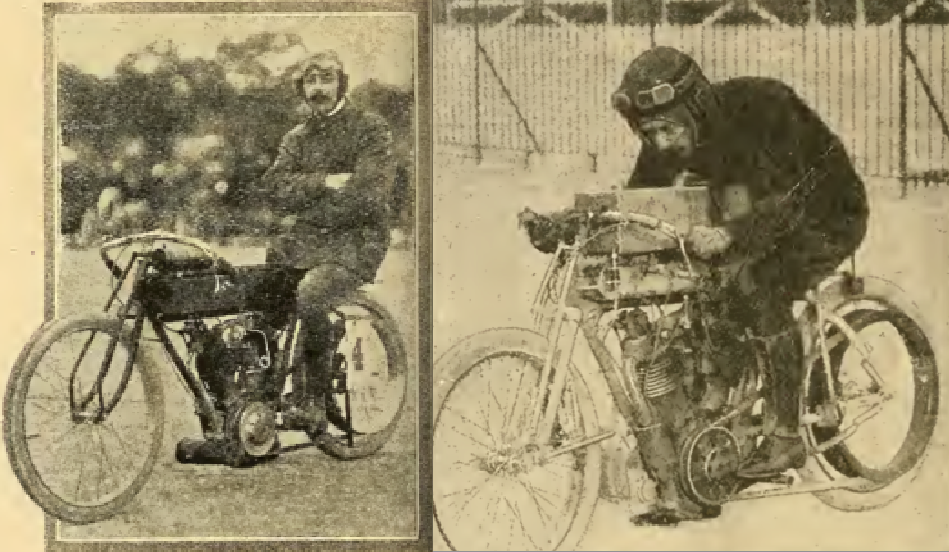
by nearly four minutes to 49min 59.4sec. Pausing only for petrol, oil and hot Bovril, Godfrey rode on to beat the 500cc one-hour record (held by HH Bowen at 59 miles 485 yards) by 865 yards to 59 miles 1,350 yards. But after another 37 minutes he was seen to be holding his magneto, which was falling off, and he was forced to retire at just under the 100-mile mark when he was 7min ahead of the record. Trivia Dept: During his run Godfrey hit a partridge that had been a mascot on the Rex stand at the Stanley show. That night he ate it.
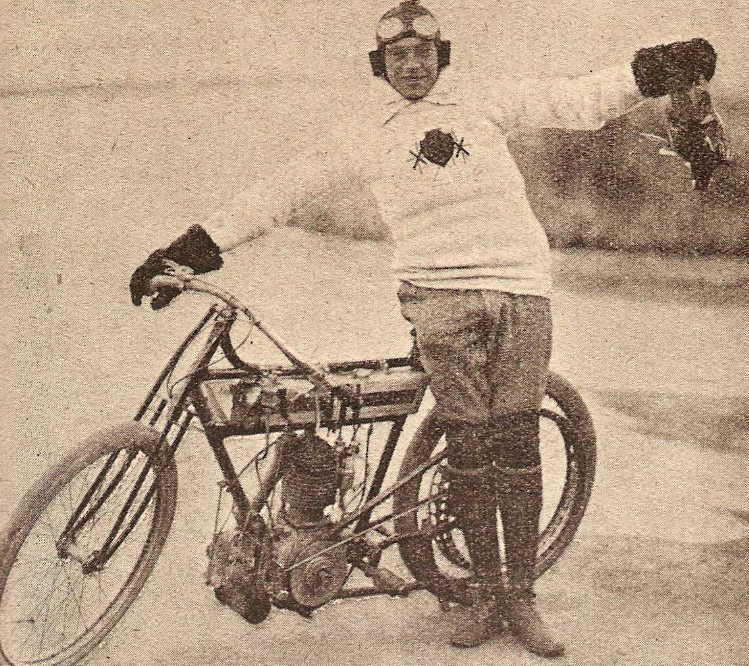
“MR AG REYNOLDS, hon secretary of the BMCRC, made the first ascent of the new Brooklands Test Hill at the official opening. The hill is 117 yards 1ft 3in long, divided up as follows: 105ft 10in of 1 in 8, 91ft 9¼in of I in 5, and 154ft 7¾in. of 1 in 4. Each section is marked by an electrical timing strip.”
ALFRED SCOTT, THE MAN BEHIND the Scott two-stroke twin, wrote: “Since the International Tourist Trophy has again been won on a British machine, it seems a favourable opportunity to raise the question of English versus French measurements, and to ask whether it is not possible to take a bold stand in favour of the use of ‘all-British dimensions’?…There really seems to be no adequate reason why in this country (or in America) the motor cycle rejoicing in a 3in cylinder should be disguised as 76mm bore, or that the easily understood capacity of 30 cubic inches should be made incomprehensible by conversion into 493 cubic centimetres! In the list of entries for the TT the capacities of the competing engines made an imposing list of cubic centimetres just about as intelligible to the general public as the numbers in a telephone directory.”
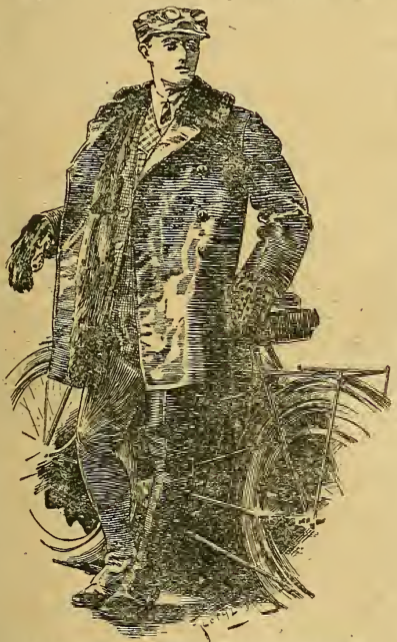
IXION WROTE: “I GENERALLY HAVE a hateful suspicion at the back of my mind when I read of a new speed record hailing from the States. I hope these suspicions of mine are wholly unworthy, and reflect rather on my own cantankerous temperament than upon the bond fides of our Yankee brother sportsmen, but I must admit that a long association with many forms of sport has generated in me an instinctive suspicion of Yankee speed records, though Wells and Lee Evans have compelled me to adopt a more open-minded attitude of late. At any rate, I am the more pleased to congratulate American motor cyclists on their recent acquisition of a splendid 24 hours’ motor bicycle record. I daresay Collier could smithereen it if only the powers that be would let him charter Brooklands for 24 hours. Two staunch Yankee riders, Spencer and Gustafsen (the latter a naturalised Swede), each riding a 5hp roadster Indian, reeled off considerably more than 1,000 miles apiece in one round of the clock, Spencer doing 1,089 miles 199 yards, and the Swede 1,043 miles. It is scarcely possible to impugn the genuineness of a distance record performed in public, and the more so when the same distance is theoretically easily within the compass of our own boys if only they could get a suitable track. What a day we should have if Collier and Lee Evans could fight out an international 24 hours at Weybridge.” And while on the subject of the USA, he added: “Although an enthusiastic supporter of English productions, I think a word of praise is due to the way Lee-Evans’s Indian went through the race. The Red Indian ran through the race with flying colours. Not a nut came loose, not a stay broke, whilst British machines were reported with burst tanks, broken mudguards and stays, as well as valves, piston rings and cylinder heads. The bad roads in tht USA have taught the Yankee how to build a motorcycle to withstand the worst possible conditions…A mechanical oil pump was fitted, and this, combined with the twist handle grip control, allowed the rider to go through the race without ever moving his hands from the rubber grips—a very good point when we remember how much difficulty some of the competitors had in controlling and steering their machines. But, in spite of this, a British machine won, and so here’s to the very good health of the winner!
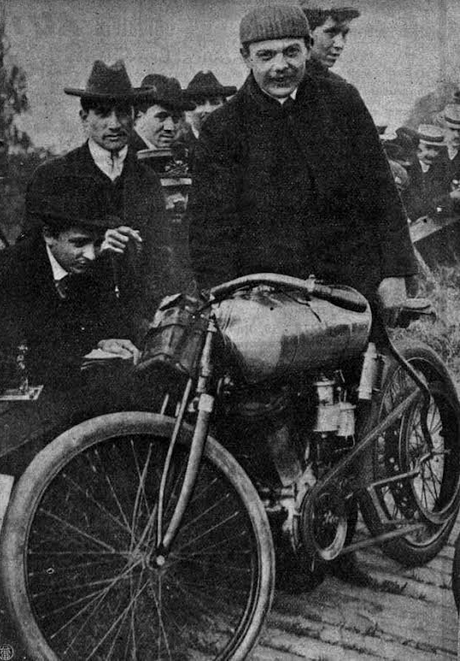
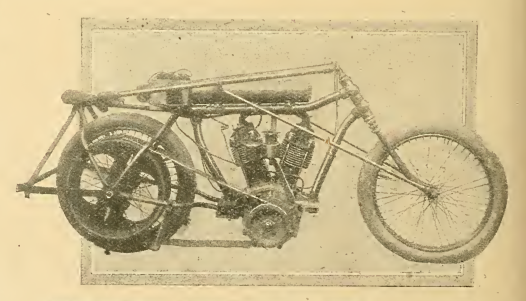
THE AGGREGATE SCORES OF THE four 1909 ACU Quarterly Trials from put 3½hp Triumphs 1st, 2nd and 3rd in the hands of Messrs Marshall, Newsome and Griesbach. In 4th, 5th and 6th places were GE Stanley (Premier), W Pratt (P&M) and FW Applebee (Rex). Having made non-stop runs in four of the 500-mile trials Marshall also won the ACU silver medal. In the final trial in the series, running from Uxbridge to Banbury and back, riders could score a maximum of 100 points: 10 each for two hillclimbs; five each for ease of starting, brakes, accessibility and stand/carrier; 10 for silencer; and 50 for reliability. Apart from the Triumph trio full marks were awarded to: W Pratt (P&M), WW Douglas (Douglas), F Dayrell (Bat), P Bischoff (Triumph), BV Jones (Premier), H Newey (LMC) and F Applebee (Rex).
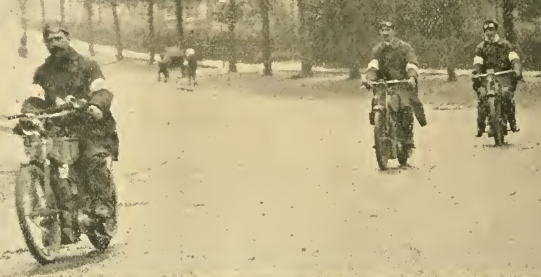
TRIUMPH EXTENDED ITS FACTORY to increase the production of hub clutches. This technology, with about 40 grooved steel plates built into the rear hub, allowed a bike to be started with its rear wheel on the ground. Control was via a heel-and-toe pedal. A user explained: “It is not only an advantage in starting, but renders a heavy motor bicycle much more mobile and convenient to handle. In traffic it is an untold blessing—no wondering whether the engine will stop and necessitate another run alongside—and on greasy roads it can be slipped to ease the jerk of the engine at slow speeds. Coasting down long hills silently and swiftly is also a fine experience, not to mention the saving of petrol and the cooling of the engine.” The all-conquering 3½hp Triumph was also given a mild makeover, starting with an increase in capacity from 476cc to what would become the industry standard 499cc with reduced compression ratio and heavier flywheels to enhance rideability. Other changes included mounting mounting the belt rim brake independent of the footrest, so in the event of a spill bending the footrest the brake would not be damaged. The oil pump was inclined towards the rider and made simpler to use. The handlebars were redesigned for a more comfortable ride; moving the toolbags to the side of the carrier (this was before they were called racks) made more room for luggage. Even the rear stand was made easier to use. The British 500 single was evolving into a worldbeater.
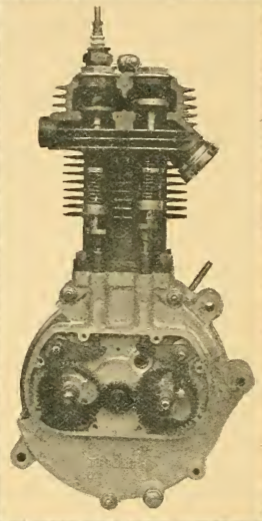
ELECTRIC HEADLIGHTS WERE BECOMING common but some riders had problems if they switched on the lights on the move. One manufactuer warned: “The metal filaments are exceedingly brittle at the moment when the current is first switched on.” The tip was to stop the bike and let the lights warm up before proceeding.
THE AMERICAN-MADE JONES speedo didn’t lack for features: a long-term season’ odometer, a trip odometer and a ‘maximum speed’ hand “giving absolutely indisputable evidence of the speed at the moment of resetting” to impress you mates. “The Jones is accepted in Court as indisputable testimony in cases of arrest for speeding” (with a reset button to dispose of the evidence and protect the guilty).
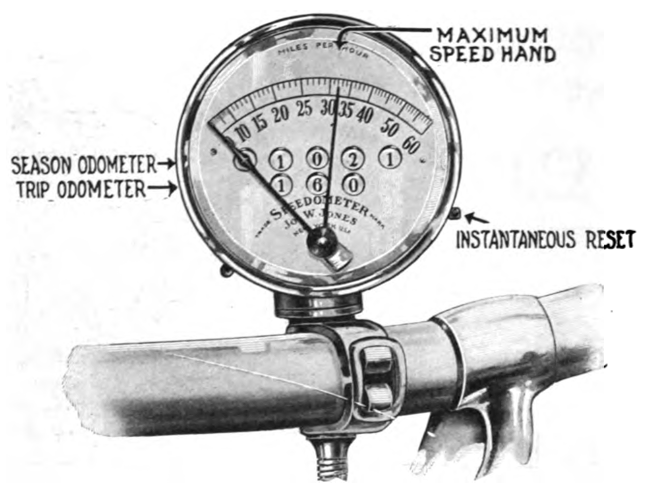
THE MANX MOTOR CYCLISTS CLUB was formed. As well as representing the 50 or so motor cyclists on the island, the club planned to look after visiting riders.
“A MOTOR CYCLIST HAS BEEN FINED £5 and 5s 6d costs for exceeding the speed limit over a furlong trap in the Croydon ten mile limit. Such unfair treatment has already been commented upon sufficiently, and we think the only thing that motor cyclists can now do is to avoid Croydon altogether.” And that remains sound advice to this very day.
BIKE CLUBS IN NEW SOUTH Wales established their own Auto Cycle Union.
THE MOTO CLUB ARGENTINA hosted its first race meeting on the outskirts of Flores with classes for motor cycles up to 3½hp and for all-comers. The flying-kilometre course was bumpy and inches deep in dust. The first 3½hp bike home was a Humber, followed by a Peugeot, an Alcyon and two FNs. First past the post in the no-limit race was a 7hp Peugeot, followed by a 5hp Peugeot, another 7hp Peugeot and a 5hp Pierce.
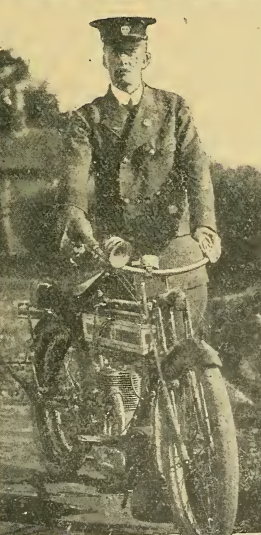
A RIDER CHARGED WITH RIDING on the footpath in Winchburgh, near Edinburgh, was let off with a 2/6d fine after the prosecution accepted the defendant’s explanation that the road had potholes “deep enough to drown a dog in”.
THE CAMBRIDGE UNIVERSITY MCC booked Brooklands and took on their Oxford counterparts in a ‘battle of the blues’, winning by seven points to six. The average club charged a few bob a year in subs; the CUMCC charged 15s a term. For this members’ bikes were stored (and cleaned) by the Cambrian Automobile Co, and the club’s rooms at the Prince of Wales Hotel was kept stocked with the motoring periodicals.
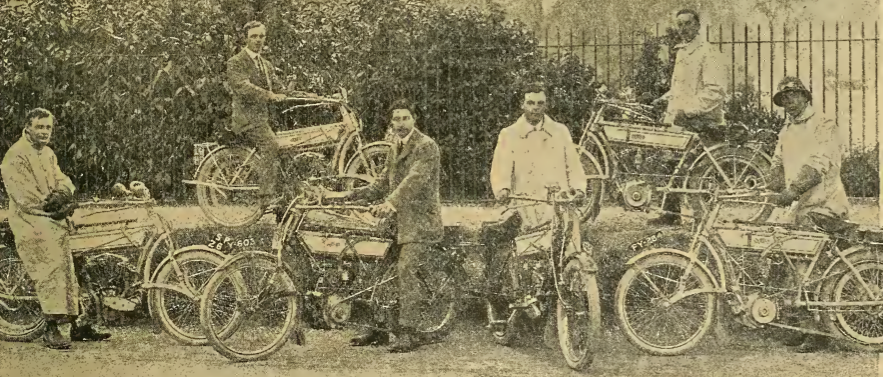
OVERSEAS RIDERS TOURING THE UK were required to re-register their machines, fit new number plates and pay for an Inland Revenue licence (VED). As one pundit put it: “What encouragement for foreign tourists to visit these shores?” British riders had similar problems when veturing abroad but later in the year an international conference hosted by the French drew up plans for ‘international driving certificates’. Parliament passed The Motor Cars (International Circulation) Bill to authorise the issue of the new licences and the first GB plates came into use.
THERE WERE 55 MOTOR CYCLE exhibitors at the Stanley show (scattered among the bicycle stands) displaying 207 bikes. NSU showed 18 of them, including a 4hp (546cc) twin with a new type of spring fork and geared down engine pulley which enabled almost-equal-sized belt pulleys to be used, reducing the risk of belt slippage. The Service Co, which imported a range of bikes and accessories, led on the 2½hp V-twin Wanderer, with sprung forks and an engine sprocket on an eccentric mount allowing belt adjustment on the move via a tank-top handle. Moto Reve lightweights had won a reputation for durability in the long-distance trials; new to the range was a two-speed 297cc in-line vertical twin and a lady’s bicycle designed to be attached to a motor cycle via a ‘coupler’ and claimed to give the passenger a more comfortable ride than a standard bicycle. A year after it returned to the motor cycle market Humber’s well-finished one-lunger was available with single- or two-speed transmission and with a choice of pedals or footrests.
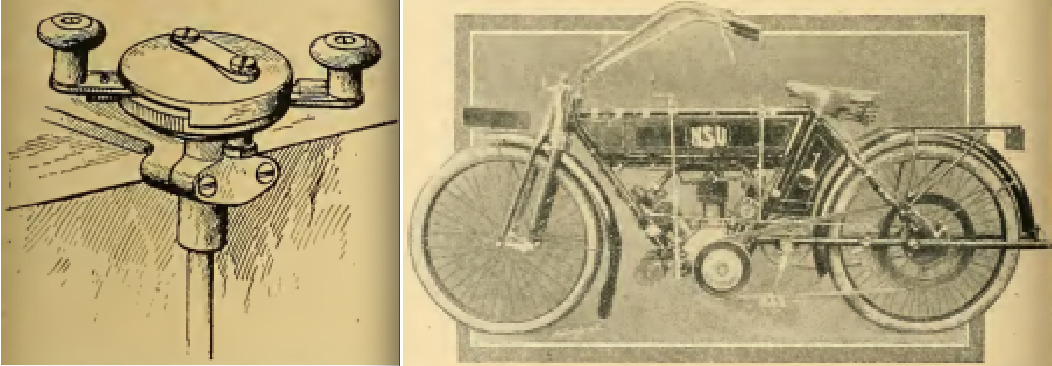
The Humber’s petrol tank came in two parts which enclosed the top tube; a step on the way to the saddle tanks which would arrive a couple of decades later. The Enfield Cycle Co came up with a lightweight powered by a 2¼hp V-twin. Fully equipped for the road including front and rear stands and a Druid-type spring fork it weighed in at just over 100lb. Starting without pedalling or running alongside was clearly a Good Thing. Norton’s 5hp twin offered a hub clutch—Norton claimed the 725cc lump could be started “by a single thrust of the pedals while seated in the saddle, the machine being stationary”. Scott made its show debut; a major point of interest was “a starting device which enables anyone to start with ease on any gradient” (the term ‘kickstart’ had yet to be coined). And the most striking feature of the LMC was a hinged footboard that doubled as a kickstart. AW Wall, the brains behind the Roc range—which, let it be noted, displayed what was
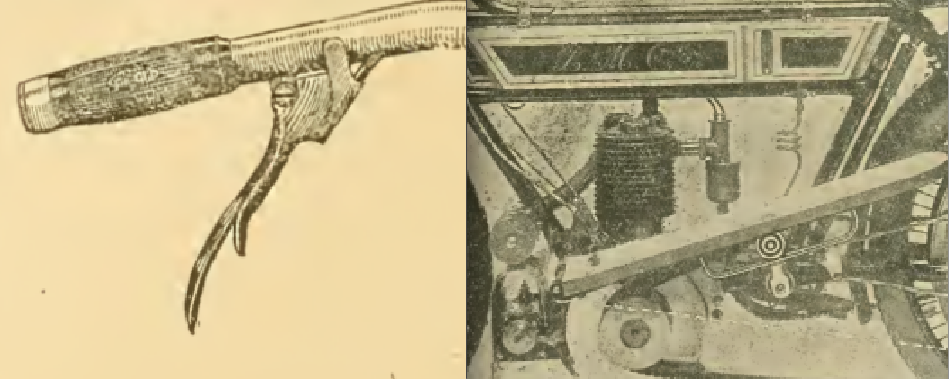
(probably) the first pressed-steel ‘monococque’ motor cycle frame–launched the ‘Wall Auto-Wheel’ which could be fitted next to the rear wheel of a conventional bicycle to convert it into a motor cycle with a top speed of some 12mph. The Auto Wheel, which weighed about 25lb, was a self-contained unit comprising an engine, magneto, carburettor, reduction gear, and fuel tank. It was described by one enthusiast at the Stanley Show as “the favourite exhibit with pedal cyclists, who gazed at it yearningly with open mouths. If all the difficulties concerned with the two-stroke design have been
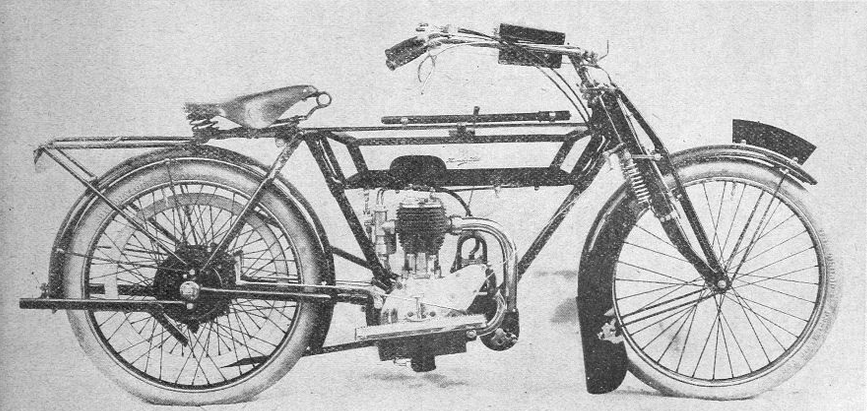
surmounted, we shall soon see thousands of these little wheels rolling push bicycles peacefully along the roads, and even if the two-stroke engine ends in failure as an application to motor cycling, I don’t see why Mr. Wall should not fit a four-cycle engine to his patent wheel. Probably he has experimented with both, and knows what he is about.” It was claimed to do 200mpg at an average of 16nph. Mind you, the Auto-Wheel was not quite the innovation some pundits believed it to be. The Singer motor wheel dated back to 1901 and the 1905 Stanley show had been graced by a three-wheeler that bore a startling resemblance to Mr Wall’s baby. In any case, the Auto-Wheel sowed the seeds for countless autocycles and mopeds and could thus be seen as the ancestor of the most successful vehicle of all time, the Honda Super Cub. There’s a thought. Mills-Fulford sidecars offered enhanced passenger comfort with the introduction of coil-spring suspension, windscreens collapsible hoods and sprung chairs. And Chater Lea made sidecar fitting more

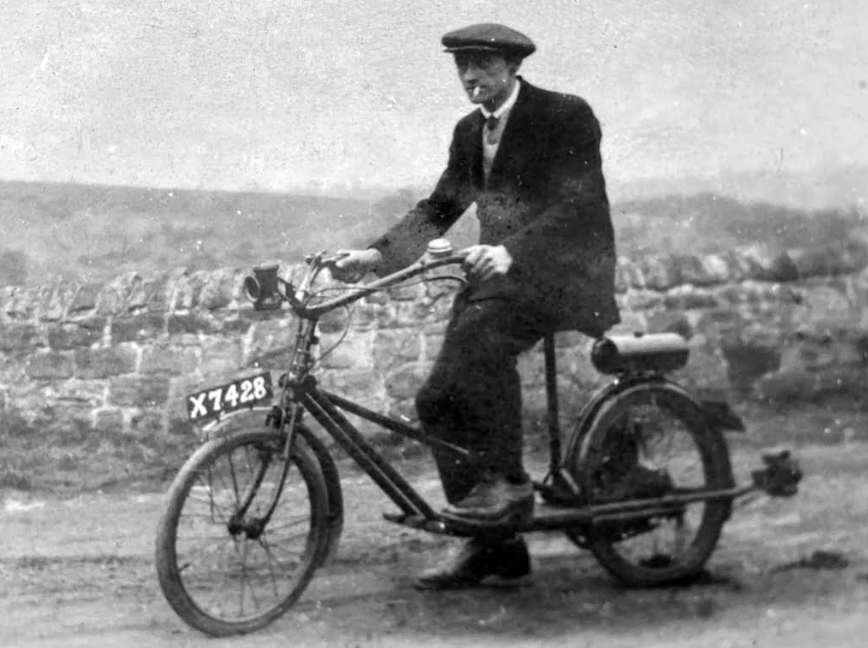
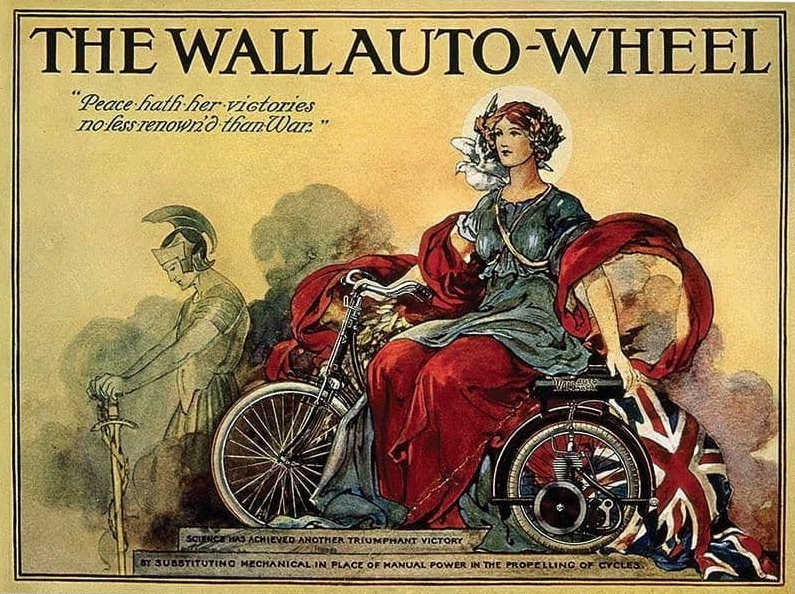
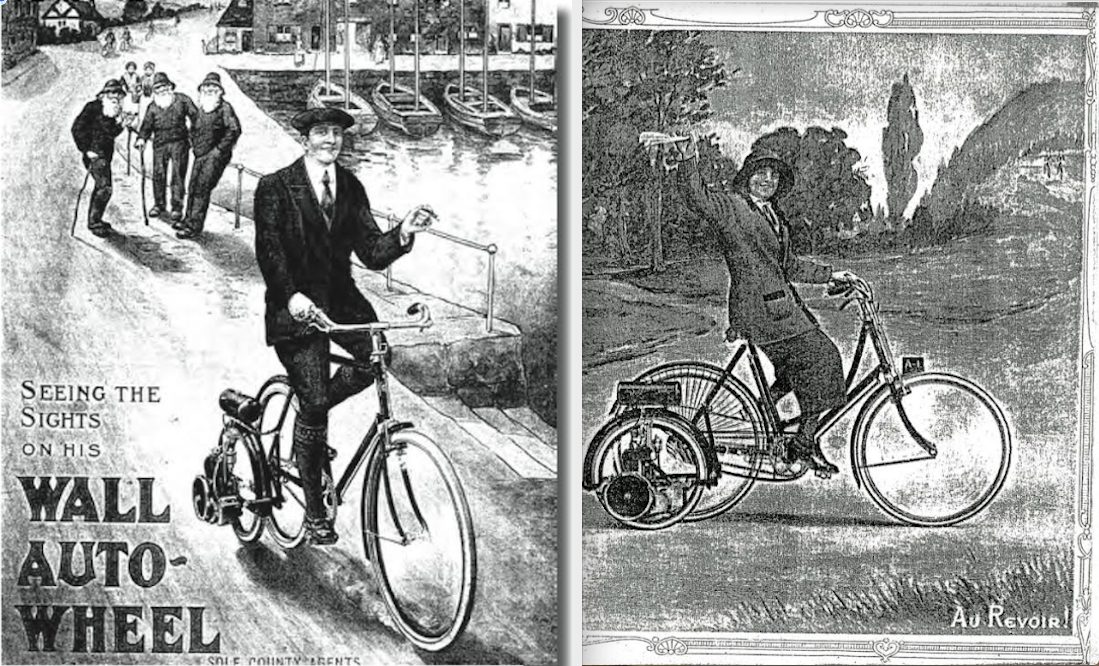
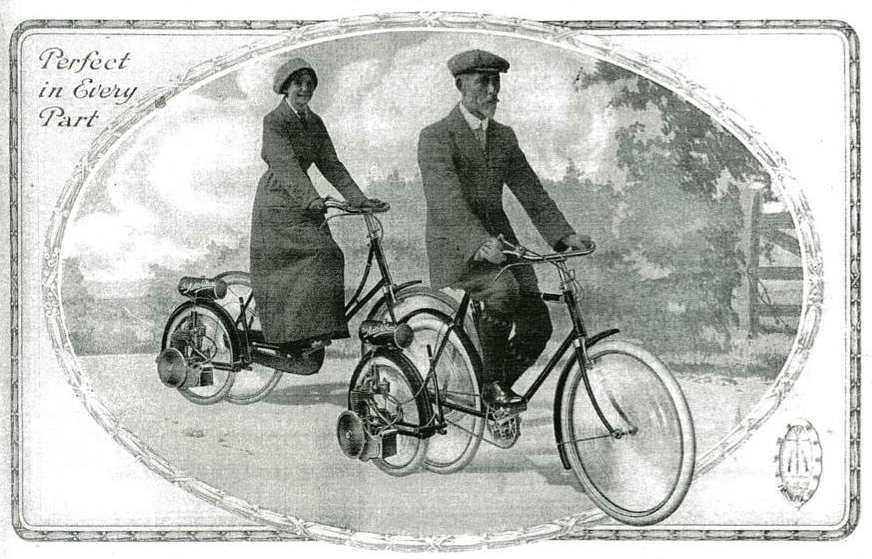
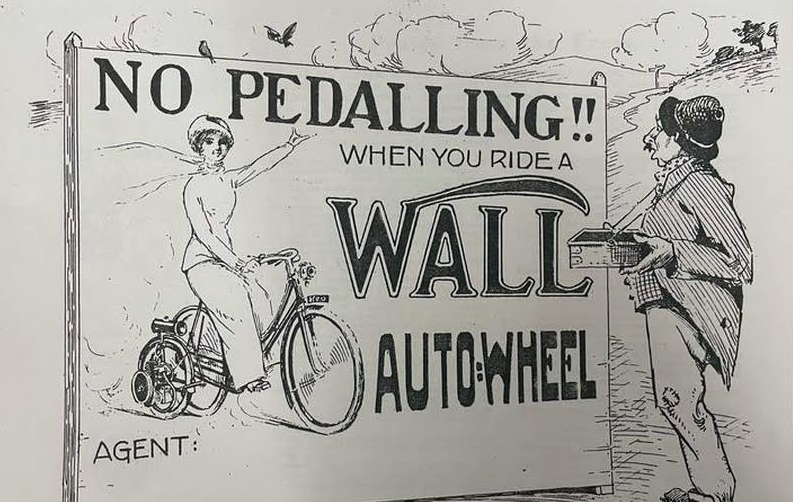
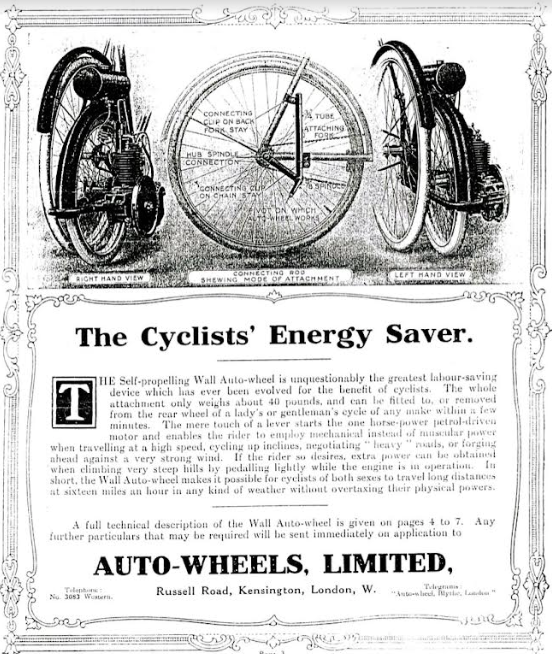
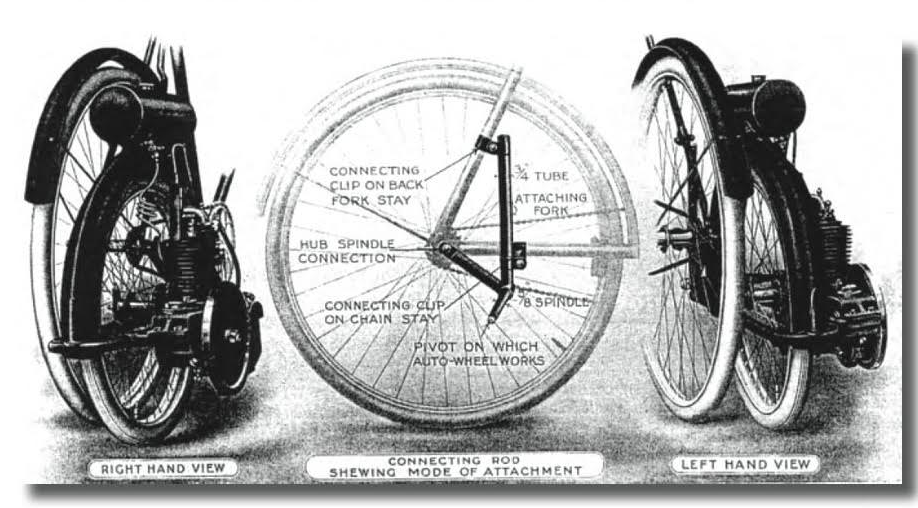
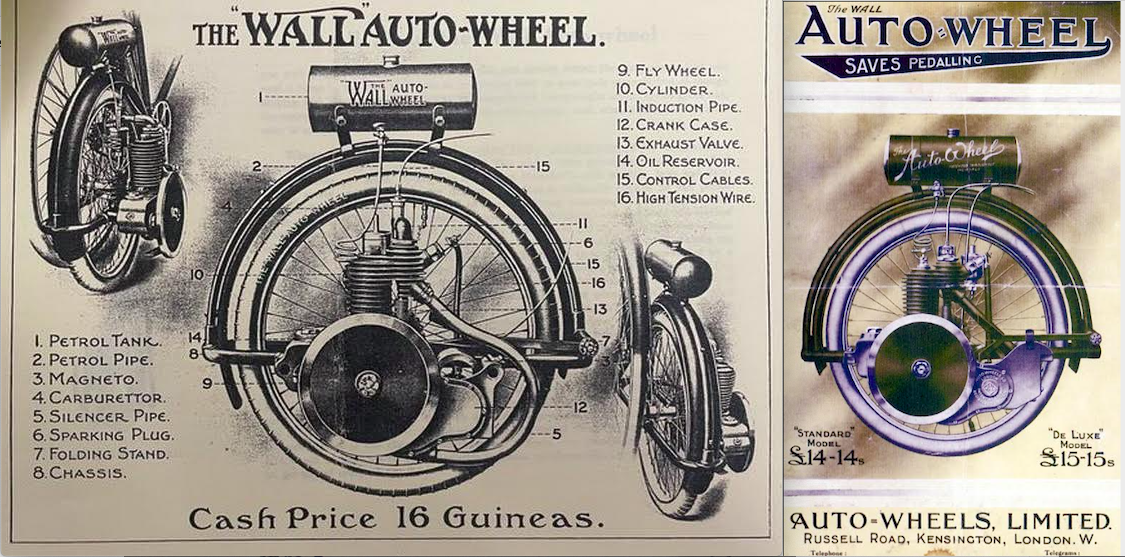
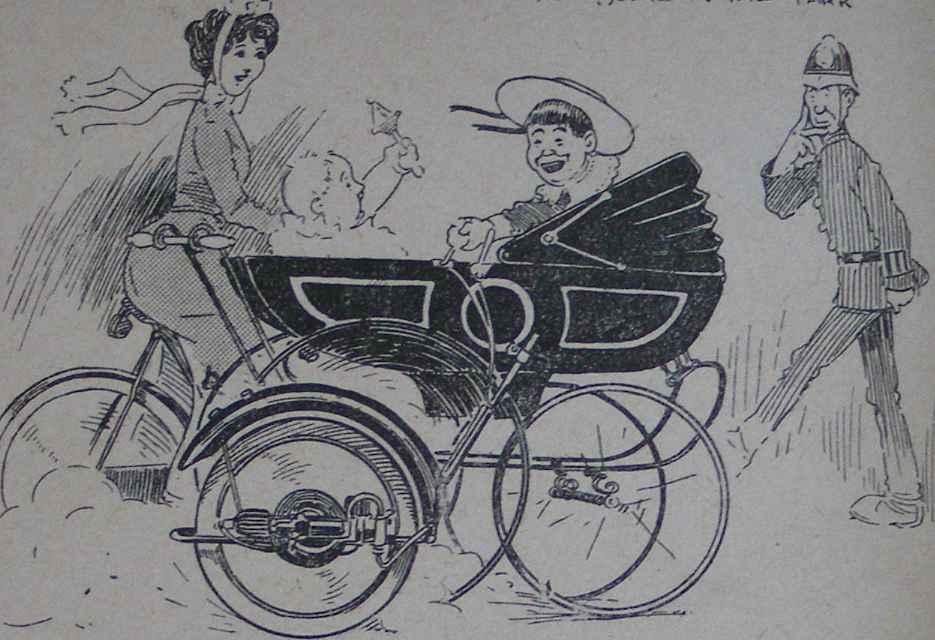
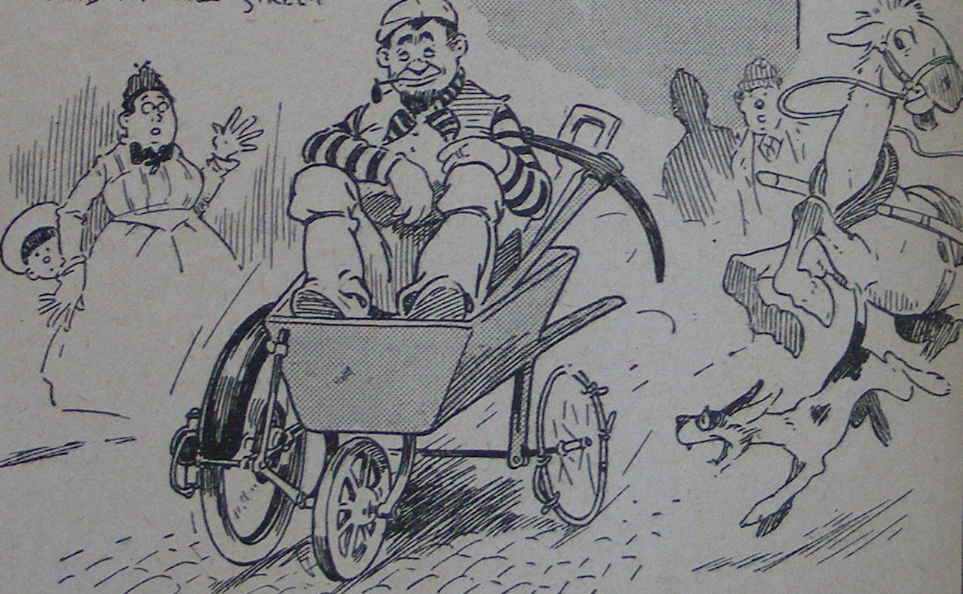

convenient with a seat pillar lug incorporating a QD fitting (the firstframes were appearing with the integral sidecar lugs that would become ubiquitous for more than half a century). Among the accessories at the Stanley show were a ‘weather screen’ in the form of a triangular roller blind mounted on the handlebars and clipping onto the front-wheel spindle. Rather more exotic was a ’diathermanous’ engine cooling system using rock salt, which was claimed to be more effective than air or water. From AMAC, later to become part of the AMAL carburettor company, came a tidy handlebar-mounted advance/retard lever and a “spare petrol tap…The tap in the central position communicates only with the raised pipe which sticks up some little way in the tank. When the flow from this sources ceases, the rider knows he has about an inch of spirit left, and then turns the tap to the right and drains the last dregs from the tank, for the tap now communicates with the tiny hole which is flush with the bottom of the petrol tank. The tap can also be turned completely off, and is automatically locked by a small stop in the two extreme positions, while a spring washer also prevents it from moving when not desired. It has the advantage of giving warning to the rider when his petrol supply is getting low, for he knows that when he has to tap his reserve supply he can only do some 10 to 12 miles on the contents of his tank. We understand that several prominent manufacturers are taking up this novel little fitment.” And in the 21st century few bikes are fitted with reserve taps. That’s progress that is. Lycett, a household name in saddles, came up with the Fit-out: a large case that strapped to the carrier with panniers hung off
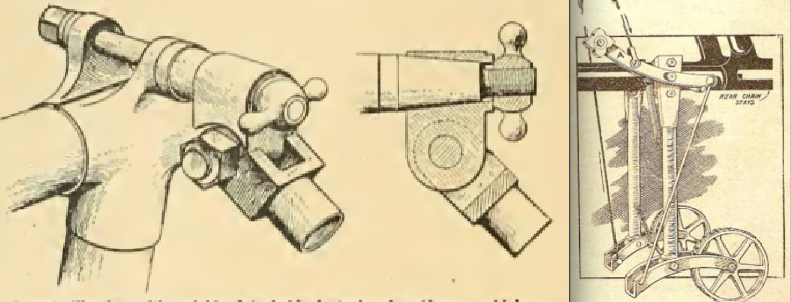
the sides, made in “waterproof tweed and leather” and setting the pattern for the later topbox and panniers. Also among the accessories was the Ukantes motor cycle prop, “a single leg fastened to a quadrant and bracket, the latter attaching to the back stay of the frame…in no sense a stand, but merely an auxiliary means of allowing the machine to stand by itself with a minimum of trouble.” A propstand in 1909. Who knew? The Jack-no-skid comprised two forks attached to the frame tubes ending into small wheels. Pulling a lever lowered the wheels which, in theory would stop a skid. At full extension the forks served as a stand. It was patented because there were similar devices on the market catering to the cowardy-custards who would now ride trikes. These included Barsby’s Patent Safety Footboards: “Several correspondents recently have mentioned the desirability of having means to enable the rider to keep the machine upright without the necessity of putting one’s feet in the mud. Barsby’s device achieves this, and considerably more, as, if combined with a clutch, it enables a motorcycle to be driven anywhere and under any condition of road or weather, exactly like a motorcar. It is so arranged that when the right footboard is depressed, the clutch is withdrawn, and the machine can remain stationery with the engine still running. By a particular adjustment of the clutch lever, it can be left so that when the footboard is down, the clutch is not quite free, but is acting as a slight brake on the engine to prevent it racing. The device also makes a very good stand. When the rider stops, he can engage two catches, which keep the boards down and allow the rider to dismount and leave the machine upright. Handle starting from the bottom bracket is provided for, and the device can be fitted by anyone to any machine, as there are only two clips to fix. Absolute immunity from sideslip under any conditions is claimed by the inventor, Mr W Barsby, 6 Cecil Court, Charing Cross Road, WC. The machine has been ridden on the London streets for the past 12 months, with full satisfaction.” And in conclusion, Ixion opined: “Spring frames are on exhibition, but personally I greatly doubt whether there is any real need to spring the whole weight of the machine and rider.” Yes, major British manufacturers were still turning out rigid frames 40 years later but that’s nothing to be proud of.
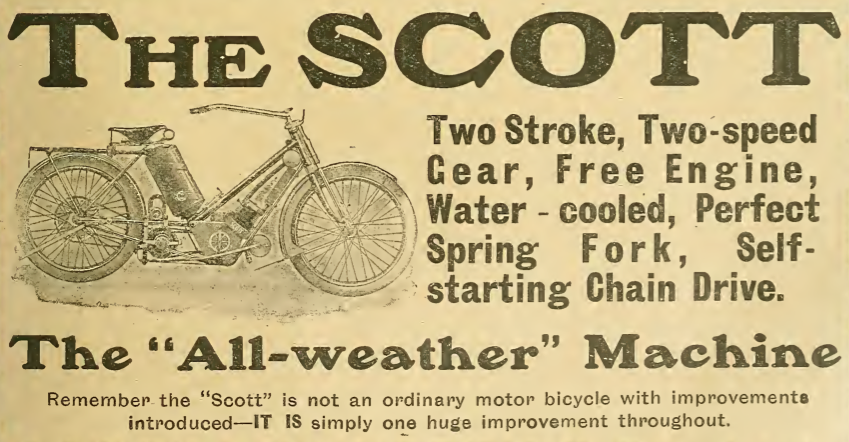
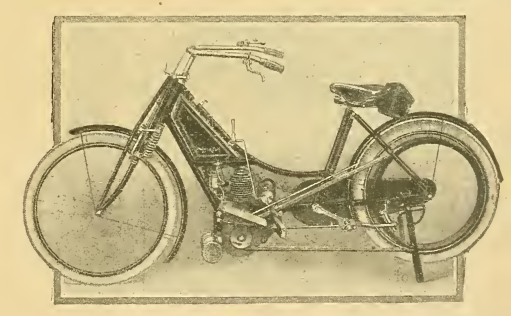
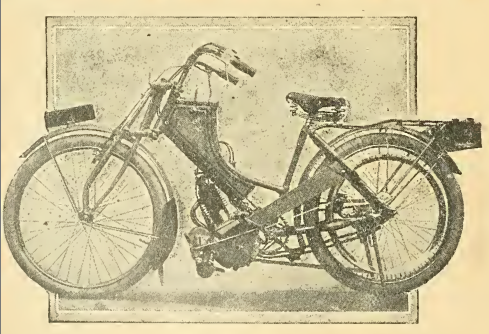
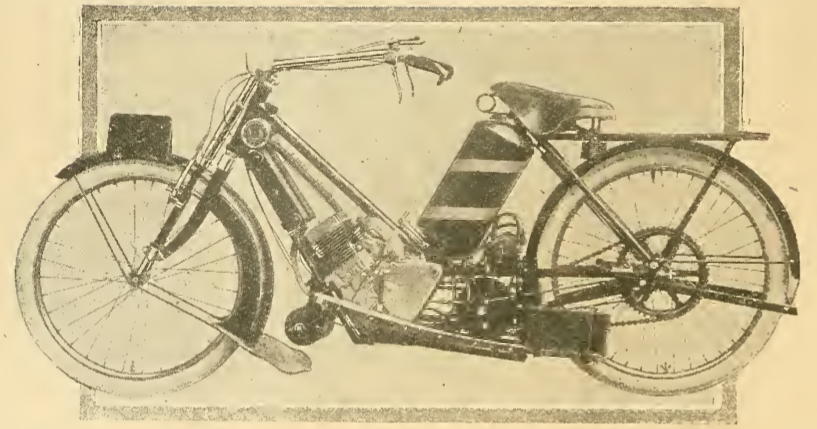
A new generation of lightweights appeared with two major improvements over their predeccesors: reliable transmissions and increased accessibility for maintenance; not least doing away withtaking the engine out for even minor tasks. The new P&M was generally seen as cream of the crop. It was slightly heavier than most imported lightweights (as was true of its compatriots) but could outperform them, both on the flat and on the hills. However the Motosacoche and Moto-Reve had already proved themselves and both had been further improved. The Wanderer and FN were also well thought of; on the homefront the P&M had support from the new Enfield twin and established tiddlers from Chater Lea, Hobart, Grandex and Wolf.
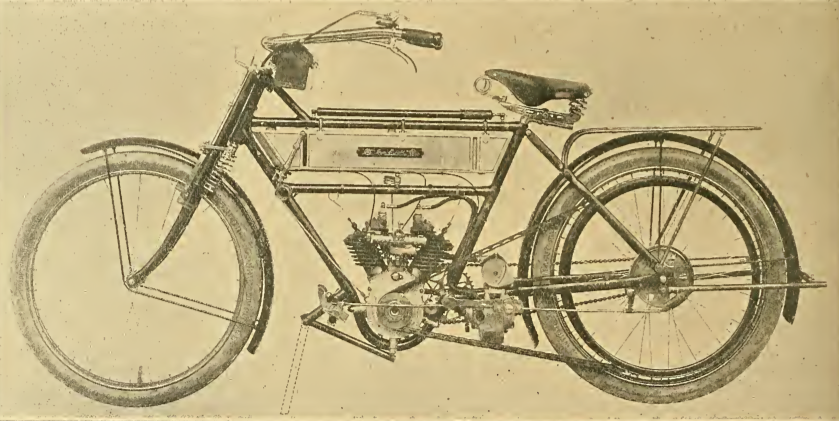
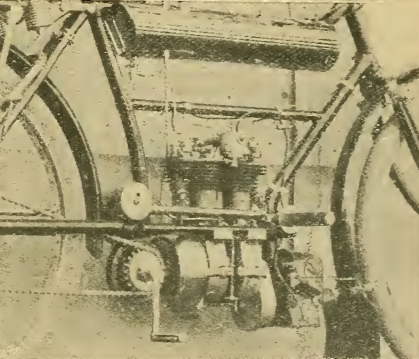
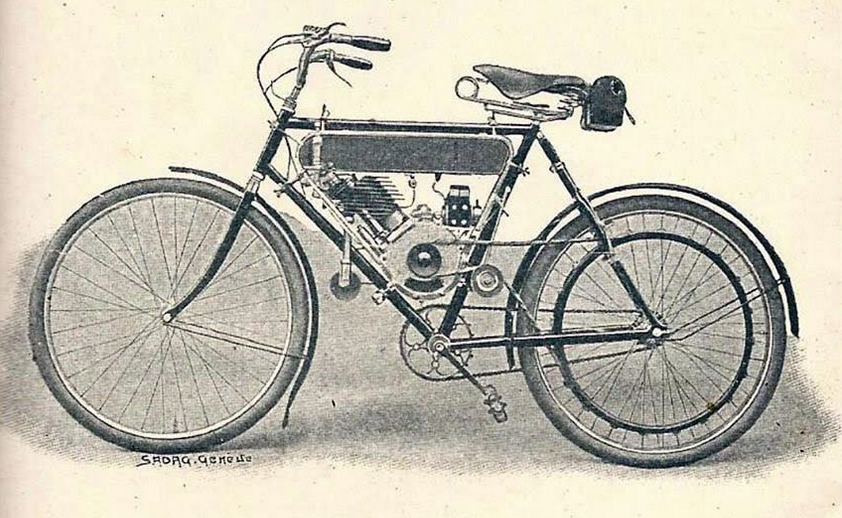
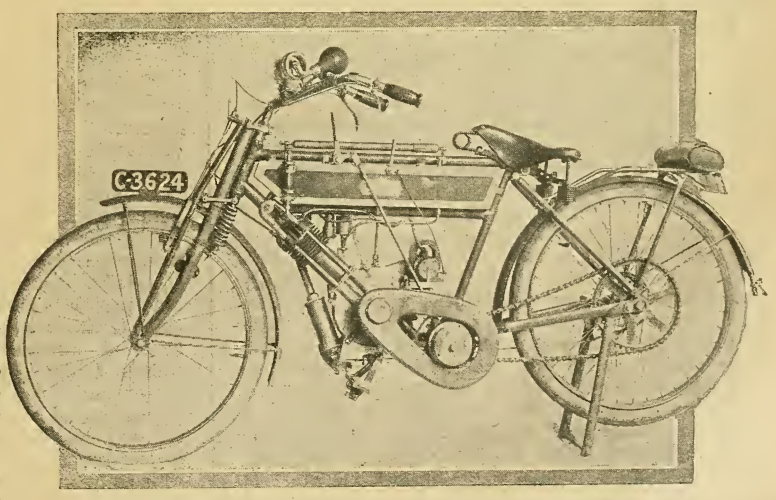
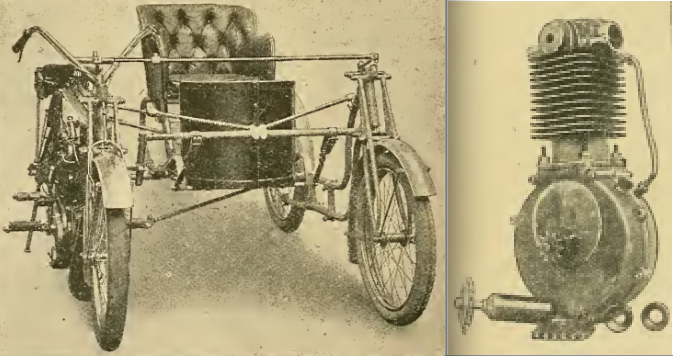
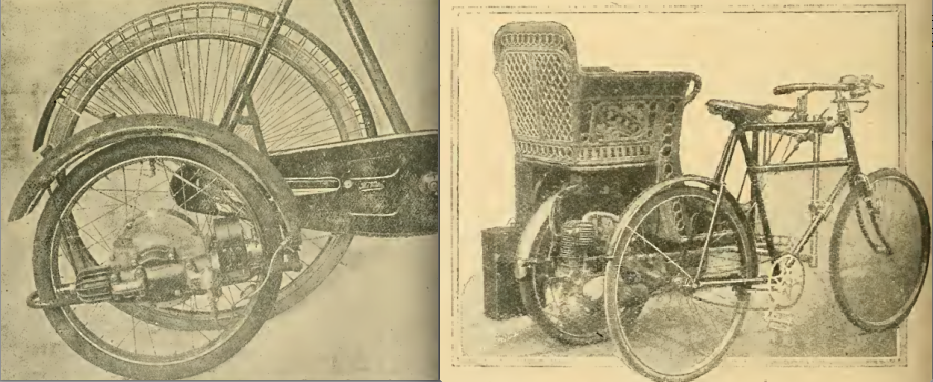
A COLUMNIST IN THE MORNING LEADER gave his view of the Stanley Show: “There were people there who ride these things, in idleness, about the country. Most of them were weakly made, and stooped, and had strained, unhealthy faces. Only a few looked as if they should be any good at a game of football, or as if they could ride a horse. There was nothing to show that they were English, and they might just as well have been French.”
AN RAC SURVEY SHOWED THERE were 75,000 motor cycles registered in the UK, up from 65,026 in 1908, 53,877 in 1907, 45,735 in 1906, 34,706 in 1905 and 21,521 in 1904, the first year such figures were published.
THE US STATES TYPICALLY ENFORCED speed limits of 8-15mph in urban areas and 20-25mph in the countryside. However, Arkansas, Georgia, Idaho,Maryland, Mississippi, Montana, Oklahoma and West Virginia and Wyoming had simply ignored motorcycles: no registration system, no licence and no speed limit. The Federation of American Motorcyclists’s legal committee published suggestions for ‘ideal’ motor cycle regulations including a 30mph speed limit and allowing a rider from one state to ride in another state for up to seven days.
A SPECIAL MEETING OF THE Cycle and Motor Trades’ Association resolved “that the motor cycle, cycle, and accessory manufacturers and traders should combine with a view to holding a show next year at Olympia, and that a committee should be appointed to discuss the matter with the Society of Motor Manufacturers and Traders”.
THE US GOVERNMENT STAGED A COMPARATIVE brake test between a horse and a motor cycle. They established that a skilled cavalryman could bring his horse to a standstill in 162ft from 25mph; a motor cyclist could stop in 147 feet.
DECADES BEFORE THE METROPOLITAN police set up the Sweeney, Sheriff Alfred T Hobley in King’s County, California recruited a ‘flying squadron’ of four motor cyclists. The idea was proposed by TK Hastings, vice-president of the Federation of American Motorcyclists. “In the event of an emergency one of the motor cyclists is pressed in service, and dashes off on his motor cycle to fulfill any order. If the sheriff requires a paper served in a hurry, the members of the squad are ready and willing to travel any distance for him. It is expected that sheriffs of other counties will follow the example of Sheriff Hobley, who, by the way, will recommend Sheriff-elect Quinn to reappoint the squad special deputy sheriffs, when the former vacates his office on December 31st.”
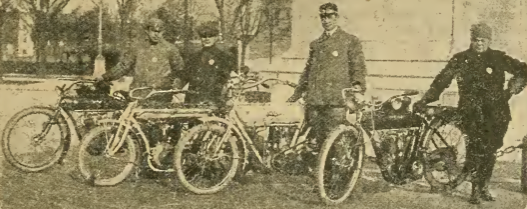

HENDEE MFG CO ORDERED 100,000ft (nearly 19 miles) of drive chain from Hans Renold. Brookes was supplying Hendee with saddles, another British fiorm had received orders for some 30,000 valves and a major order for tubing was in the pipeline. This despite the fact that American importers had to stump up a 45% import tariff. “Taking it all together,” the Blue ‘Un suggested, “there will be very little of the material in the machine apart from the engine which is not of British production, so even the most patriotic motor cyclists will join us in applauding the Hendee Co for its first year’s success in England.”
THE US MAGAZINE MOTORCYCLE ILLUSTRATED published a list of 257 makes of motor cycle with their countries of origin. The author was Miss M Low of 23 College St, Homerton, in the East End of London. Her address corresponds to a pub, the Princess Alice, and a contemporary census shows Walter J Low resident as a ‘beer retailer’; presumably her dad. Why did a publican’s daughter have such a wide knowledge of motor cycles? Well, she shared a surname with one Archibald Low who would have been 21 when Miss Low was compiling her list and might have been a cousin or uncle. It’s safe to say he knew a bit about bikes; in a long and extremely eventful career he would design his own motor cycle, race at Brooklands and spend 24 years as chairman of the ACU (qv gallimaufry). In any case, here’s Miss Low’s list, with abbreviations (A), American; (AU), Austrian; (B), Belgian; (D), Dutch; (E), English; (F), French; (G), German;
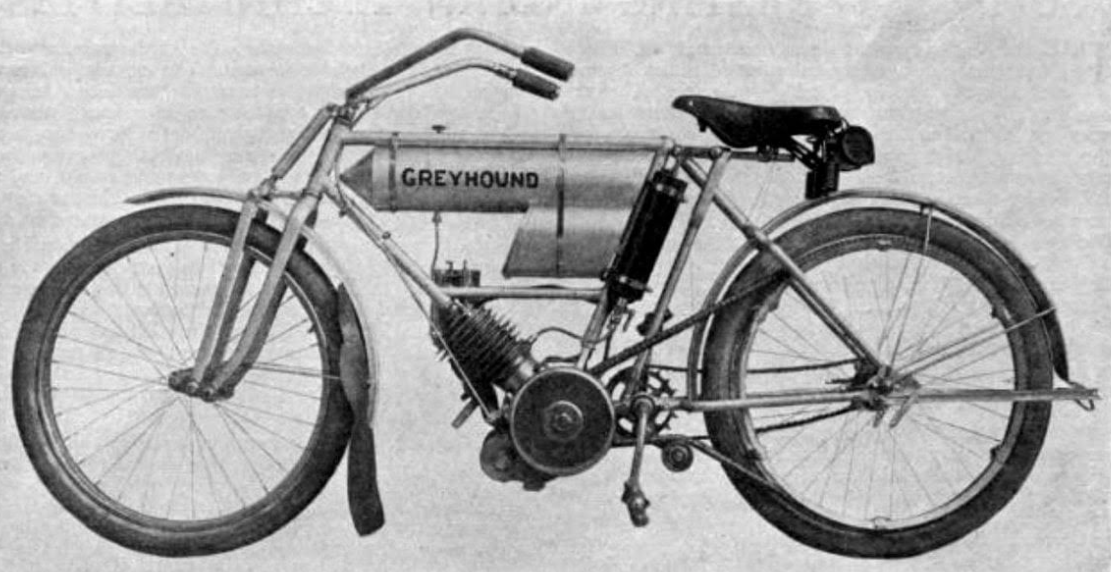
(RU), Russian; (U), Unknown): AC (E), Acacia (E), Acme, (E), Adler (G), Advance (E), Alcyon (F), Alldays (E), American (A), Anglian (E), Antoine (B), Apache (A), Armac (A), Ariel (E), Arno (E), Armadale (E), Aster (F), Atelier (F), Auto-Bi (A), Auto-Fanteuil (F), Autooto (F), Baddeley (E), Barnes (E), Barry (E), Baxter (E), Bat (E), Benktink (E), Bercley (E), Bichrone (E), Bid (A), Binks (E), Blizzard (E), Bowden (E), Bradbury (E), Bradley (A), Brannabas (G), Branson (A), Bren (A), Brooklands (E), Brough (E), Brown (B), Californian (A), Caldert (E), Campion (E), Carlton (E), Certain (E), Chappell (A), Chater-Lea (E), Chase (E), CCR (U), CIE (E), Clarendon (E), Clement (E), Clement Garrard (E), Clessold (E), Clyde (E), Comet (E), Corah (E), Cotterean (E), Coventry Eagle (E), Crouch (A), Crownfield (E), Curtiss (A), CVS (A), Daw (E), Daymar (E), DEC (E), De Dion (F), Derby (E), Diamond (E), Dot (E), Douglas (E), Durkopf (G), Durwent (E), Duc (E), Eddie (E), EDF (A), Eland (E), Elf Kink (E), Elgin (A), Emblem (D), Eole (A), Erie (A), Excelsior (A), Eyesink (D), Fairy (E), Feilback (A) Fleetwing (E), FN (Belgian), Gamage (E), GB (G), GOK (E), Gobron Minerva (F), Goricke (A), Green Egg (A),
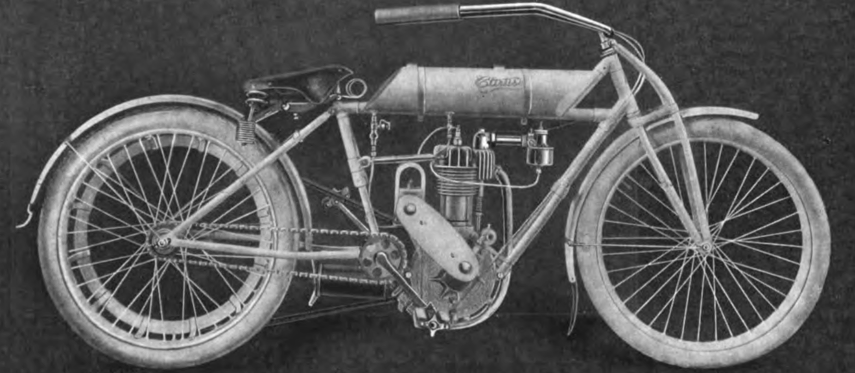
Greyhound (A), Griffon (F), Guarantee (U), Hadlef (E), Harley Davidson (A), Herlte Bruneau (F), Hewittson (E), HH (U), Hilaman (A), Hobart (E), Holdert (E), Holley Auto-Bike (RU), Hopper (E), Hornecker (A), Hulbert Bramlead (E), Humber (E), Indian (A), Invicta (E), Ivel (E), Jones (E), JAP (E), Jehle (U), Jehu (F), Jowett (E), Juno (E), KD (F), Kelecom (B), Kerry (E), Kynoch (E), Lagonda (E), Lanadere (F), Langham (E), Laurin & Klement (Au),Lazarus (U), Leader (E), Light (A), Licoln Elk (E), Linden (U), LMC (E), Lurquin Coudert (AU), MAB (E), Mabon (E), Madison (A), Magnet (G), Mansfield (E), Munson (A),
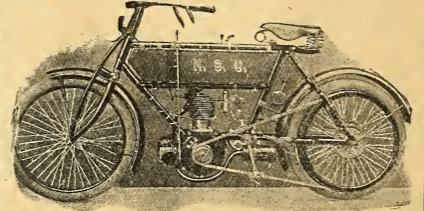
Marlborough (E), Mars (G), Marsh (A), Matchless (E), Max (E), Metz (A), Merkel (A), Midget Bicar (A), Minerva (B), Minneapolis (A), Mitchell (A), MM (A), MMC (E), Montgomery (E), Moorhampton (E), Motor Reve (F), Motosachoche (F), New Century (E), New Era (A), New Hudson (E), Noble (E), NLG (E), Norton (E), NSU (G), Oakleight (E), Onaway (U), Orient (A), Ormonde (F), Ortona (A), Osborne (E), Osmonde (E), Pace (E), Pebok (E), Peiper (B), Peugeot (F), Phanoman (B), Phelon & Moore (E), Phoenix (E), Pioneer (E), Pierce (A), Precision (E), Premier (E), Princeps (E), Progress (B), Puch (A), Pumbret (E), Quadrant (E), Raleigh (E), Rambler (A), R&P (E), Regina (E), Reliance (A), Rex (E), Relief (E), Rip (E), Roc (E), Romania (B), Rover (E), Royal (A), Royal Ajax (E), Royal Consort (E), Royal Enfield (E), Royal Pioneer (A), Royal Sovereign (E), Rushworth (E), Reading Standard (A), Sarolea (B), Scott (E), Scout (E), Service (E), Sharp (E), Shaw (E), Silver (E), Simms (E), Simplex (A), Sinclair (E), Singer (E), Sprinter (E), Star (E), Starlet (E), Stevens (A), Styria (A), Swallow (E), Swift (E), The King (Cambridge) (E), Thomas Auto-Bi (A), Thomas (E), Thiem (A), Thor (A), Thoroughbred (A), Torpedo (A), Trafalgar (E), Triumph (E), Trump-JAP (E), Vinco Minerva (E), Vindec (E), VS (E), Waddington (E), Wagner (A), Wallace (E), Weller (E), Werner (F), Westfield (E),
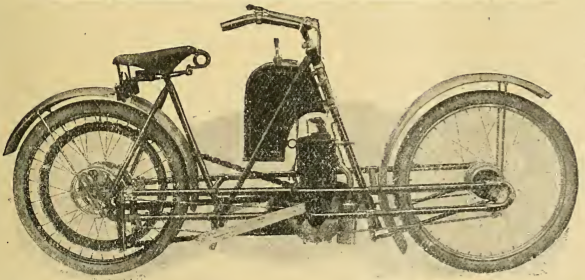
Westlake (E), Whitley (E), Wolf (E), Yale (A), Zedel (B), Zenith (E), Zenette (E). Whoever advised her, Miss Low’s list is very far indeed from perfect. anderer, for example, was listed as Russian rather than German (perhaps she wrote ‘Prussian’ and a geographically challenged Yankee copy editor became confused). Then there was ‘Pugh (RU)’ which, allowing for a typo in the name, translates as Puch (G). The fine German marque NSU was described as Belgian. Among marques simply omitted, some of them high profile, were Regal (E), OK Supreme (E), Oreol (F) whose main factory rider Cissac set oodles of records, Orion (Czech), Olympic (E), OEC (E), Opel (G), Austral (F), Victoria (Scotland), Victoria (G), Vibratelle (F), Vulcan (Czech), Walter (Czech) and Rene-Gillet (F). Rambler, classified (U) was American, so that Yankee copy editor was having a bad day, and AJS (E) which had only just been launched so let’s make allowances. On the other hand, Ormonde (F) was listed three years after its demise.
THE BLUE ‘UN PUBLISHED A definitive table of 1909 records in January 1910 but it makes sense to include them here:
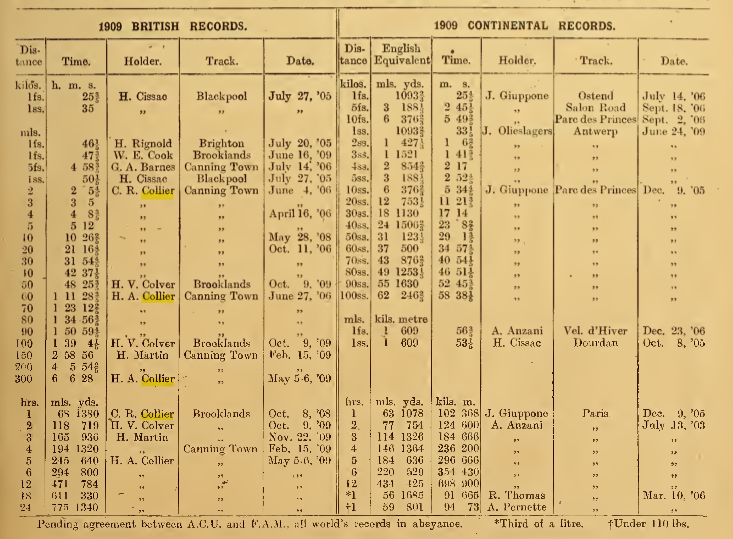
“BELOW IS A LIST OF MOTOR cycle records accepted by the Federation of American Motor Cyclists (the governing body of the pastime in America). It will be noticed that our American cousins have a separate list of ‘amateur records’, but we may explain that the American amateur definition is very different from the English one. A trade rider is an amateur in America, provided he has never competed for a cash prize. We are assured by Dr JP Thomley (chairman of the FAM Competition Committee) that ‘the records have been made with the greatest care and under the strictest supervision’. He adds: ‘There are no records in the world which have been more carefully gotten up, and every possible factor of error eliminated. It gives me great pleasure to forward this list to you, and the Federation of American Motor Cyclists will greatly appreciate your publishing these records in your valuable journal.'”
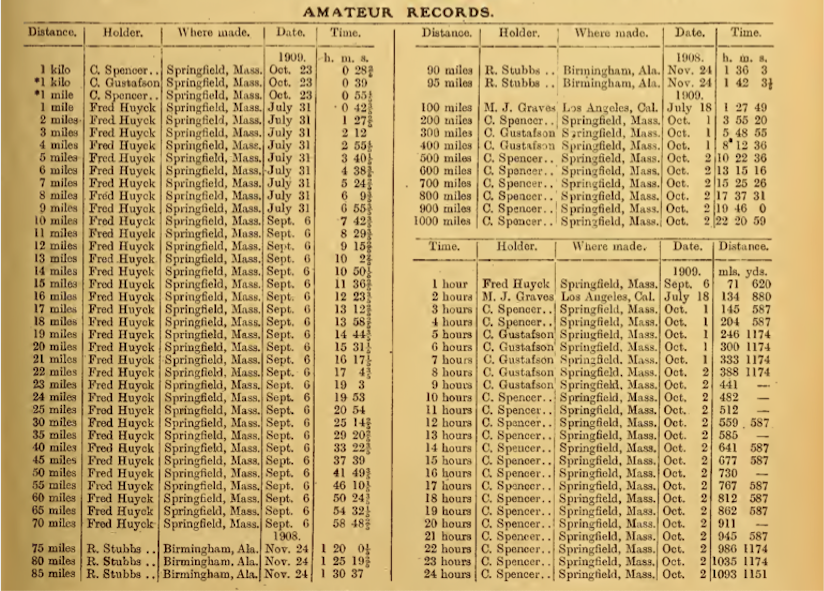
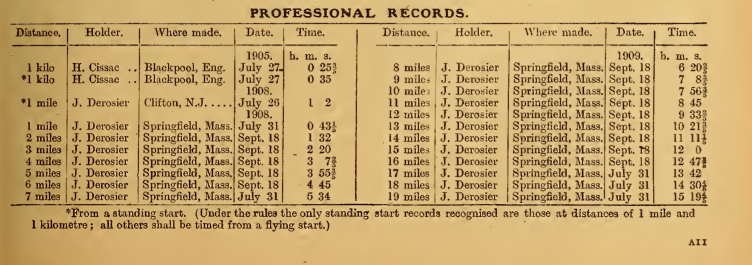
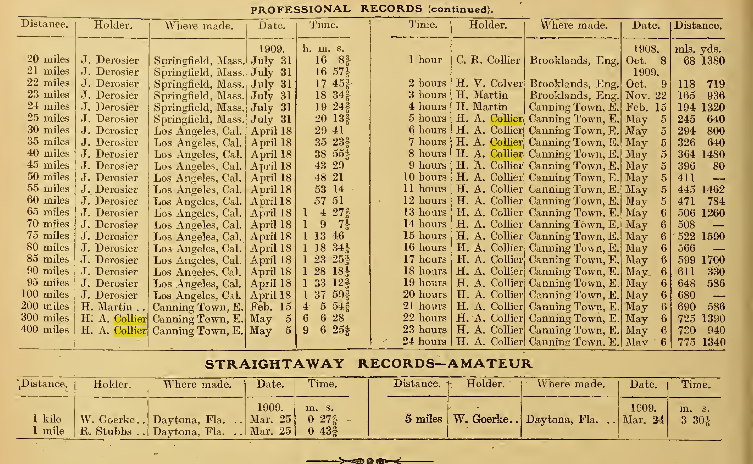
OK that sums up motor cycling in 1909; we’ll conclude with some charming Christmas ephemera, Christmas greetings from the Green ‘Un and a selection of contemporary ads.
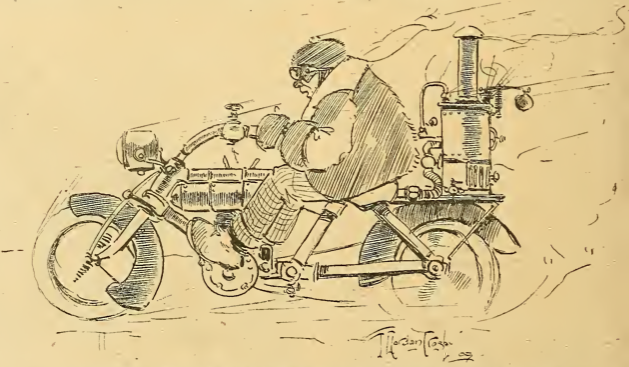
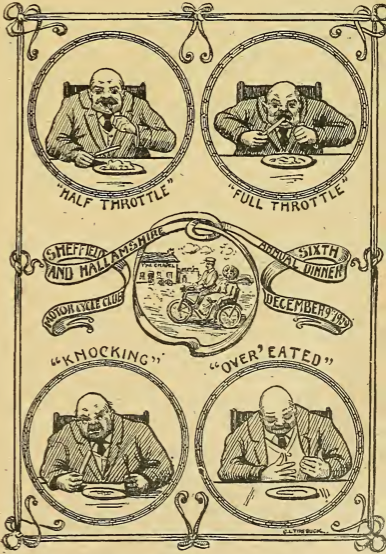
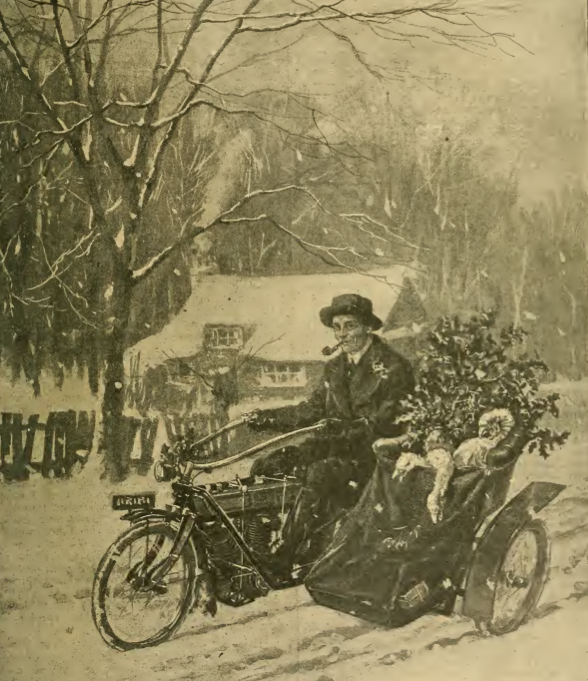
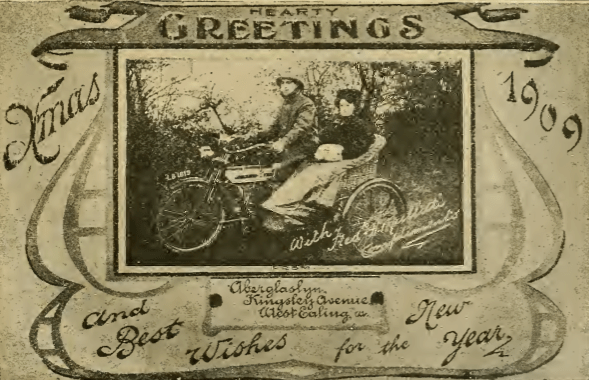
“COMPLIMENTS OF THE SEASON. The Editor and staff take this fitting opportunity of wishing all readers of The Motor Cycle a Happy Christmas and a Prosperous New Year. As in past years a portion of the presesnt issue is devoted to the lighter side of motor cycling. The article, ‘A Peep into the Future’, cannot fail to interest all at this season of the year.” You’ll find this article in the 1909 Features section.
